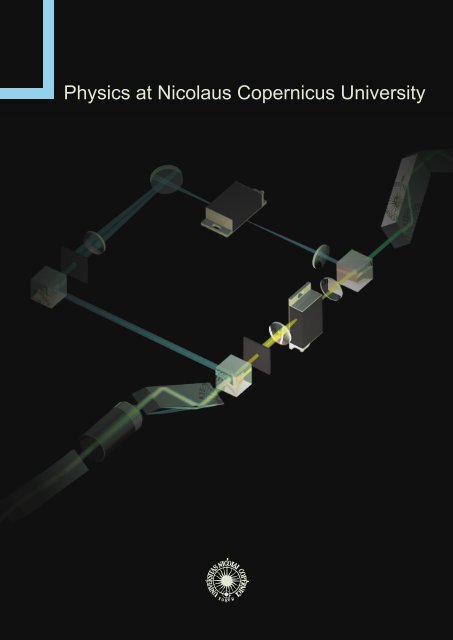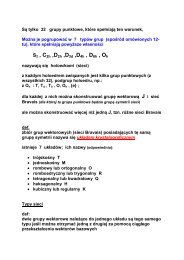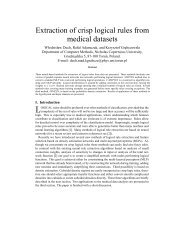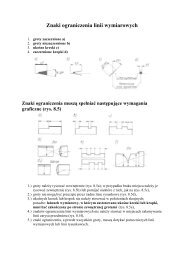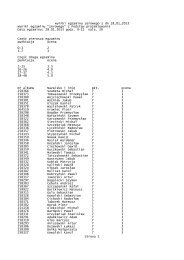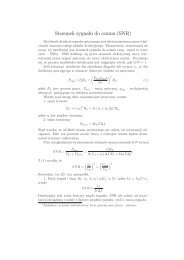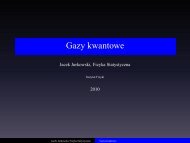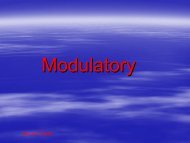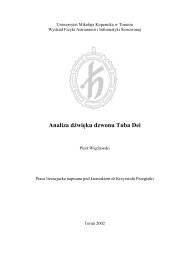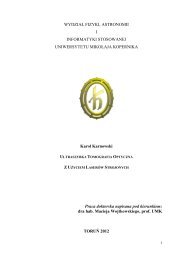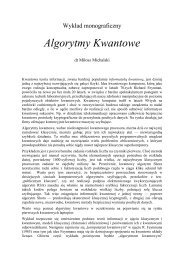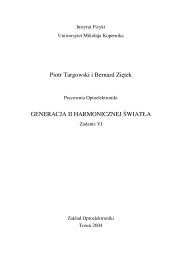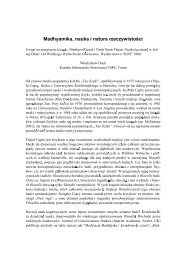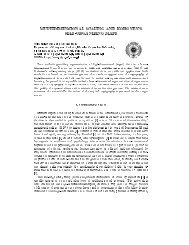Physics at Nicolaus Copernicus University
Physics at Nicolaus Copernicus University
Physics at Nicolaus Copernicus University
You also want an ePaper? Increase the reach of your titles
YUMPU automatically turns print PDFs into web optimized ePapers that Google loves.
<strong>Physics</strong> <strong>at</strong> <strong>Nicolaus</strong> <strong>Copernicus</strong> <strong>University</strong>
Edited by<br />
Miros³aw Bylicki<br />
Photographs by<br />
Miros³aw Bylicki<br />
Roman Ciury³o<br />
Czes³aw Koepke<br />
Tomasz Korzeniewski<br />
Carlos Lopez-Mariscal<br />
Mi³osz Michalski<br />
Wiktor Najder<br />
Lucjan H. Oczkowski<br />
Tadeusz Robaczewski<br />
Janusz Strzelecki<br />
Pawe³ Szroeder<br />
Design by<br />
Dominik Pop³awski<br />
ISBN 83–231–1824–8<br />
Toruñ, 2005<br />
Instytut Fizyki UMK<br />
Printed by<br />
POZKAL, ul. Cegielna 10/12, Inowroc³aw<br />
On the cover:<br />
Electromagnetically induced transparency system<br />
for the light storing (FAMO Lab)
<strong>Physics</strong> <strong>at</strong> <strong>Nicolaus</strong> <strong>Copernicus</strong> <strong>University</strong><br />
Institute of <strong>Physics</strong><br />
http://www.phys.uni.torun.pl/phys<br />
tel.: (48–56) 611–32–29<br />
fax: (48–56) 622–53–97<br />
e-mail: ifiz@phys.uni.torun.pl<br />
Department of Inform<strong>at</strong>ics<br />
http://www.phys.uni.torun.pl/kmk<br />
tel.: (48–56) 611–33–10<br />
fax: (48–56) 622–15–43<br />
e-mail: wduch@phys.uni.torun.pl<br />
<strong>Nicolaus</strong> <strong>Copernicus</strong> <strong>University</strong>, Grudzi¹dzka 5, 87–100 Toruñ, Poland<br />
N<strong>at</strong>ional Labor<strong>at</strong>ory for Atomic,<br />
Molecular and Optical <strong>Physics</strong><br />
http://www.phys.uni.torun.pl/famo<br />
tel.: (48–56) 611–33–33<br />
fax: (48–56) 622–53–97<br />
e-mail: famo@phys.uni.torun.pl
Historically, Toruñ is one of the most important cities in Poland. It also is one<br />
of the most <strong>at</strong>tractive and best preserved. Having survived centuries of wars and conflicts<br />
the city offers a wealth of architectural treasures. In 1997 Toruñ was included<br />
in the UNESCO World Heritage List.<br />
This booklet is a report on the physics research<br />
<strong>at</strong> <strong>Nicolaus</strong> <strong>Copernicus</strong> <strong>University</strong>. It covers the activity<br />
of three units. Two of them: the Institute of <strong>Physics</strong><br />
and the Department of Inform<strong>at</strong>ics are regular parts<br />
of the Faculty of <strong>Physics</strong>, Astronomy and Inform<strong>at</strong>ics.<br />
The third one, the N<strong>at</strong>ional Labor<strong>at</strong>ory for Atomic, Molecular and<br />
Optical <strong>Physics</strong> was founded in 2002 as a n<strong>at</strong>ional facility open<br />
to researchers of the whole Country.<br />
The booklet presents the research interests r<strong>at</strong>her than the<br />
results. The upd<strong>at</strong>ed inform<strong>at</strong>ion about the projects, results,<br />
public<strong>at</strong>ions, researchers etc. can be found in our WWW pages<br />
http://www.phys.uni.torun.pl
Contents<br />
<strong>Physics</strong> in Toruñ<br />
Departments of the Institute of <strong>Physics</strong><br />
Department of Atomic, Molecular and Optical <strong>Physics</strong><br />
Department of Quantum <strong>Physics</strong><br />
Department of M<strong>at</strong>hem<strong>at</strong>ical <strong>Physics</strong><br />
Department of Semiconductor and Carbon <strong>Physics</strong><br />
Department of Optoelectronics<br />
Department of Technical and Applied <strong>Physics</strong><br />
Department of Biophysics and Medical <strong>Physics</strong><br />
Department of the Theory of Many-Electron Systems<br />
The Educ<strong>at</strong>ion of <strong>Physics</strong> Labor<strong>at</strong>ory<br />
Department of Inform<strong>at</strong>ics<br />
N<strong>at</strong>ional Labor<strong>at</strong>ory for Atomic, Molecular and Optical <strong>Physics</strong><br />
Library<br />
<strong>Physics</strong> Journals Edited in Toruñ<br />
4<br />
6<br />
9<br />
14<br />
15<br />
18<br />
20<br />
22<br />
25<br />
26<br />
28<br />
30<br />
31<br />
32
4<br />
<strong>Physics</strong> in Toruñ<br />
History<br />
<strong>Nicolaus</strong> <strong>Copernicus</strong> <strong>University</strong> in Toruñ was founded in the fall of 1945.<br />
On January 1. 1946, Aleksander Jab³oñski (1898–1980) was appointed full<br />
professor of experimental physics of the <strong>University</strong> and charged with the task<br />
of organizing its Department of <strong>Physics</strong>. Working in the very difficult postwar<br />
years, in a country totally destroyed by World War II, he was able to establish<br />
here, as early as the beginning of the 1950's, a scientific center for experimental<br />
and theoretical studies in <strong>at</strong>omic and molecular physics, in particular, in his<br />
own fields of research on luminescence of liquids, gases and solids as well as<br />
Aleksander Jab³oñski<br />
pressure effects on spectral lines. This center consisted <strong>at</strong> th<strong>at</strong> time of the<br />
Department of <strong>Physics</strong> of <strong>Nicolaus</strong> <strong>Copernicus</strong> <strong>University</strong> and the Labor<strong>at</strong>ory for Photoluminescence of the<br />
Polish Academy of Sciences. It was loc<strong>at</strong>ed in Collegium Physicum — an <strong>University</strong> building completed in<br />
1951 <strong>at</strong> Grudzi¹dzka street. In the beginning the Department of <strong>Physics</strong> consisted of two Chairs: Experimental<br />
and Theoretical <strong>Physics</strong>. Holding the Chair of Experimental <strong>Physics</strong>, Jab³oñski also contributed to initi<strong>at</strong>ing<br />
research in other fields, such as solid st<strong>at</strong>e physics and, in the following years, quantum electronics and<br />
molecular biophysics.<br />
Apolonia Wrzesiñska<br />
Kazimierz Antonowicz<br />
Jerzy Rayski<br />
Jan Rzewuski<br />
Research in the field of solid st<strong>at</strong>e physics<br />
began in 1951 when Apolonia Wrzesiñska<br />
(1910–1997) started her studies on<br />
photoluminescence and thermoluminescence<br />
phenomena in solids.<br />
In 1956, Kazimierz Antonowicz (1914–2002)<br />
initi<strong>at</strong>ed his pioneering experiments in nuclear<br />
magnetic resonance (NMR). L<strong>at</strong>er, he applied<br />
successfully radiospectroscopic techniques<br />
to the study of the properties of carbon<br />
m<strong>at</strong>erials.<br />
Wanda Hanus<br />
Two Professors of theoretical physics: Jerzy Rayski (1917–1994; the Chair in 1947–1957) and Jan Rzewuski<br />
(1916–1994), who achieved widely acclaimed results in quantum field theory and in the theory of elementary<br />
particles, played an important role in the development of physics <strong>at</strong> <strong>Nicolaus</strong> <strong>Copernicus</strong> <strong>University</strong>.<br />
Rzewuski left Toruñ in 1953 when he accepted the chair of theoretical physics <strong>at</strong> the <strong>University</strong> of Wroc³aw.<br />
In 1957 Rayski moved to Cracow where he was appointed professor of theoretical physics <strong>at</strong> the Jagellonian<br />
<strong>University</strong>. Rayski's successor to the Chair of Theoretical <strong>Physics</strong> of <strong>Nicolaus</strong> <strong>Copernicus</strong> <strong>University</strong> till 1969<br />
was Wanda Hanus (1914–1973). Her research work was devoted to the theory of <strong>at</strong>omic spectra and<br />
rel<strong>at</strong>ivistic quantum mechanics.
In 1958, Wies³aw WoŸnicki (1933–1995) joined the Theoretical<br />
<strong>Physics</strong> Chair. He came from Warsaw just afer he had got the<br />
Ph. D. degree under Leopold Infeld. In early 1960s he g<strong>at</strong>hered<br />
several young researchers who formed an informal group<br />
interested in chemical physics and quantum chemistry. In 1970’s<br />
and 1980’s the group was very strong as the Department of<br />
Chemical <strong>Physics</strong> headed by Professor WoŸnicki. Several<br />
Departments working nowadays have origin<strong>at</strong>ed from th<strong>at</strong> one.<br />
In 1991, Brian G. Wybourne (1935–2003)<br />
from the <strong>University</strong> of Canterbury in<br />
Christchurch, New Zealand joined our<br />
faculty. He spent in Toruñ his last twelve<br />
years working on applic<strong>at</strong>ions of symmetry<br />
in physics. He strongly influenced<br />
the development of the scientific<br />
community in Toruñ.<br />
Brian G. Wybourne<br />
In 1966, Professor Roman S. Ingarden (presently retired, Doctor Honoris Causa of <strong>Nicolaus</strong> <strong>Copernicus</strong> <strong>University</strong>)<br />
came from Wroc³aw to Toruñ to take the newly cre<strong>at</strong>ed Chair of Thermodynamics and Theory of Radi<strong>at</strong>ion.<br />
In Toruñ he developed research in the field of m<strong>at</strong>hem<strong>at</strong>ical physics, in particular on the found<strong>at</strong>ions of st<strong>at</strong>istical<br />
physics. He has had a gre<strong>at</strong> influence on the further development of physical sciences in Toruñ.<br />
In the middle 1960's, the Department of <strong>Physics</strong> of <strong>Copernicus</strong> <strong>University</strong> consisted of four Chairs:<br />
Experimental <strong>Physics</strong> (A. Jab³oñski), Electronics and Solid St<strong>at</strong>e <strong>Physics</strong> (K. Antonowicz), Theoretical <strong>Physics</strong><br />
(W. Hanus), and Thermodynamics and Theory of Radi<strong>at</strong>ion (R. S. Ingarden). Professor Jab³oñski was the head<br />
of the Department from its beginning in 1946 until his retirement in 1968.<br />
In 1969, the structures of <strong>University</strong> faculties were reorganized: institutes — units coordin<strong>at</strong>ing the<br />
scientific and educ<strong>at</strong>ional activities of various research groups — were founded. The Department of <strong>Physics</strong><br />
was replaced by the Institute of <strong>Physics</strong>. The first Director of the Institute was Roman Ingarden (from 1969<br />
until 1978). In the following years, this post was held successively by Ryszard Bauer (1978–1981),<br />
Lutos³aw Wolniewicz (1981–1983), Józef S. Kwi<strong>at</strong>kowski (1984), and Józef Szudy (1984–2002). Currently,<br />
Stanis³aw Chwirot is the director.<br />
Nowadays<br />
Wies³aw WoŸnicki<br />
Now, the Institute of <strong>Physics</strong> consists of eight research departments and of Educ<strong>at</strong>ion of <strong>Physics</strong><br />
Labor<strong>at</strong>ory. The Institute is a part of the Faculty of <strong>Physics</strong>, Astronomy and Inform<strong>at</strong>ics. Another part<br />
of the Faculty is the Department of Inform<strong>at</strong>ics. It arose in 1991 from the Institute and now is independent<br />
of it. Nevertheless, its research activity apart from inform<strong>at</strong>ics is also physics, especially<br />
comput<strong>at</strong>ional methods of physics. In 2002<br />
another physics research unit was established<br />
in Toruñ: N<strong>at</strong>ional Labor<strong>at</strong>ory for<br />
Atomic, Molecular and Optical <strong>Physics</strong>.<br />
It offers gre<strong>at</strong> experimental equipment and it<br />
is open via a grant system to all researchers<br />
of Poland.<br />
All these three units are loc<strong>at</strong>ed in the<br />
<strong>University</strong> building known for many years as<br />
Collegium Physicum <strong>at</strong> Grudzi¹dzka street.<br />
In 1980, after the de<strong>at</strong>h of Professor<br />
Jab³oñski, th<strong>at</strong> name was replaced by the<br />
Aleksander Jab³oñski Institute.<br />
5
6<br />
Department of Atomic, Molecular<br />
and Optical <strong>Physics</strong><br />
Head: Prof. dr hab. Józef Szudy<br />
Prof. dr hab. Andrzej Bielski<br />
Prof. dr hab. Stanis³aw Chwirot<br />
Doc. dr hab. Franciszek Bylicki<br />
Dr hab. Felicja Mruga³a<br />
Dr hab. Tadeusz Orlikowski<br />
Dr hab. Piotr Rudecki<br />
Dr hab. Ryszard S. Trawiñski<br />
Dr Konrad Banaszek<br />
Dr Roman Ciury³o<br />
Dr Jolanta Domys³awska<br />
Dr Dariusz Dziczek<br />
Dr Daniel Lisak<br />
Dr Mariusz Piwiñski<br />
Dr Jerzy Wolnikowski<br />
Wiktor Br¹czkowski<br />
The Department is composed of three research groups.<br />
Ph. D. students:<br />
Piotr Mas³owski, M. Sc.<br />
£ukasz K³osowski, M. Sc. eng.
High Resolution Spectroscopy Group<br />
Andrzej Bielski – head of the group, Józef Szudy, Franciszek Bylicki,<br />
Ryszard S. Trawiñski, Piotr Rudecki, Roman Ciury³o, Jolanta Domys³awska,<br />
Daniel Lisak, Jerzy Wolnikowski, Piotr Mas³owski<br />
High resolution spectroscopy methods are used to gain a better understanding of the mechanisms<br />
of optical collisions in the gas phase resulting from the inter<strong>at</strong>omic and intermolecular interactions<br />
involving excited st<strong>at</strong>es. Main <strong>at</strong>tention is focused on both experimental and theoretical studies of<br />
pressure broadening, shift and asymmetry of <strong>at</strong>omic spectral lines perturbed by neutral particles such<br />
as ground-st<strong>at</strong>e <strong>at</strong>oms or molecules. Laser-induced fluorescence (LIF) technique as well as pressurescanned<br />
Fabry-Perot interferometers are used to determine more subtle fe<strong>at</strong>ures of spectral line shapes<br />
in dilute gases. These fe<strong>at</strong>ures include: speed-dependent effects, correl<strong>at</strong>ion between velocity-changing<br />
and dephasing collisions as well as effects due to the finite dur<strong>at</strong>ion of collisions.<br />
Using a LIF method precise measurements of pressure-broadened profiles of the 326.1 nm<br />
1 3 114<br />
intercombin<strong>at</strong>ion line (5 S 0 – 5 P 1)<br />
of the even-even Cd isotope perturbed by all rare gases and some<br />
molecular gases (H 2, D 2, N 2 and CH 4 ) were performed <strong>at</strong> pressures up to 600 Torr. The line shapes<br />
were analyzed in terms of a Speed-Dependent Asymmetric Voigt Profile (SDAVP) and the role of the<br />
correl<strong>at</strong>ion between pressure broadening r<strong>at</strong>e and emitter velocity as well as of the finite dur<strong>at</strong>ion of<br />
collisions were thoroughly investig<strong>at</strong>ed. The velocity-changing collisions were described by the billiardball<br />
(BB) model, which allows us to capture the dependence of velocity-changing collisions on the r<strong>at</strong>io<br />
á of the mass of perturber to emitter. For Cd-Xe (á=1.15) we have observed th<strong>at</strong> the Doppler width of<br />
the 326.1 nm Cd line obtained from the fit of the measured profile to the ordinary Voigt profile is<br />
significantly smaller than the value corresponding to the cell temper<strong>at</strong>ure. To verify the reason for this<br />
narrowing we have used an Asymmetric Billiard-Ball Profile (ABBP) as well as Speed-Dependent ABBP<br />
in which Dicke narrowing is taken into account using the BB model. The Dicke narrowing itself cannot<br />
completely elimin<strong>at</strong>e departures between the fitted BB and experimental profiles. Contrary to th<strong>at</strong> the<br />
use of SDAVP, which takes into account correl<strong>at</strong>ion between pressure and Doppler broadening but<br />
neglects Dicke narrowing, gives rise to residuals which are spread uniformly about zero. Good quality<br />
of SDAVP fit indic<strong>at</strong>es th<strong>at</strong> narrowing of <strong>at</strong>omic lines is really domin<strong>at</strong>ed by speed dependence of<br />
pressure broadening and shift r<strong>at</strong>es and the role of Dicke narrowing is diminished in the optical domain.<br />
Other topics of interest deal with:<br />
1. Determin<strong>at</strong>ion of total cross-sections for impact broadening and shift<br />
114<br />
of the 326.1 nm Cd line perturbed by various <strong>at</strong>omic and molecular perturbers;<br />
2. Line-mixing asymmetry in profiles associ<strong>at</strong>ed with the hyper-fine-structure components<br />
1 3 113<br />
of the intercombin<strong>at</strong>ion transition (5 S 0 – 5 P 1)<br />
of the even-odd Cd isotope;<br />
3. Influence of velocity-changing collisions (Dicke narrowing) and line mixing on infrared<br />
1 1<br />
molecular lines in the 03 0 ‹ – 01 0 Q branch of N2O (in collabor<strong>at</strong>ion with the group<br />
of J.D. Drummond and A.D. May <strong>at</strong> <strong>University</strong> of Toronto, Canada);<br />
4. Pressure broadening and shift of H2O and C2H 2 lines in the region around 3 ìm<br />
(in collabor<strong>at</strong>ion with the group of A. Sasso <strong>at</strong> Universita di Napoli, Italy);<br />
5. Properties of photoassoci<strong>at</strong>ion spectra near the intercombin<strong>at</strong>ion line (the weak transition<br />
1 3<br />
between S 0 and P 1 st<strong>at</strong>es) of cold alkaline earth <strong>at</strong>oms; calcul<strong>at</strong>ions have been carried<br />
out for calcium <strong>at</strong>oms colliding <strong>at</strong> ultra low temper<strong>at</strong>ures of 1mK, 1 ìK and 1 nK<br />
(in collabor<strong>at</strong>ion with the group of Paul S. Julienne <strong>at</strong> N<strong>at</strong>ional Institute of Standards and<br />
Technology, Gaithersburg, MD, USA);<br />
6. At the end of 2004 a magneto-optical trap (MOT) was built. In the near future it will be used<br />
to study the properties of cold Rb <strong>at</strong>oms <strong>at</strong> temper<strong>at</strong>ures of about 100 ìK.<br />
Torunian MOT<br />
7
8<br />
Fundamental Atomic Interactions Group<br />
Stanis³aw Chwirot – head of the group, Konrad Banaszek, Dariusz Dziczek,<br />
Mariusz Piwiñski, £ukasz K³osowski<br />
Sophistic<strong>at</strong>ed experimental methods are used to study some of the fundamental interactions<br />
of <strong>at</strong>oms. Special techniques are applied to limit the extent of averaging over experimental<br />
parameters and provide d<strong>at</strong>a which characterize researched phenomena <strong>at</strong> the level as close<br />
to single interaction event as possible.<br />
Present scope of interest of the group include:<br />
1. Electron impact excit<strong>at</strong>ion of <strong>at</strong>oms<br />
– electron-photon coincidence technique is used to acquire d<strong>at</strong>a on electron impact<br />
coherence parameters (EICP) which characterize properties (the shape and sp<strong>at</strong>ial<br />
orient<strong>at</strong>ion) of the electron cloud of the excited <strong>at</strong>om immedi<strong>at</strong>ely after the collision with<br />
1 1<br />
electron (currently, 4 S 1 – 5 P1 excit<strong>at</strong>ion of cadmium <strong>at</strong>oms is studied),<br />
– measurements of optical excit<strong>at</strong>ion functions (dependence of excit<strong>at</strong>ion cross section on<br />
electron energy) and polariz<strong>at</strong>ion functions (energy dependence of polariz<strong>at</strong>ion of electron<br />
impact-induced fluorescence);<br />
2. Coherent interactions of <strong>at</strong>oms with multiple radi<strong>at</strong>ion fields —<br />
<strong>at</strong>omic media in the st<strong>at</strong>e of Coherent Popul<strong>at</strong>ion Trapping (CPT)<br />
– propag<strong>at</strong>ion of light pulses with electromagnetically-controlled group velocity,<br />
– “light storage” – suspension of propag<strong>at</strong>ion of light pulses in <strong>at</strong>omic media;<br />
3. Entangled photons and quantum inform<strong>at</strong>ion processing<br />
– gener<strong>at</strong>ion of tailored single-photon wave packets in non-linear media,<br />
– protecting coherent superposition st<strong>at</strong>es in quantum communic<strong>at</strong>ion.<br />
Molecular Collision Theory Group<br />
Tadeusz Orlikowski – head of the group, Felicja Mruga³a<br />
Graphical represent<strong>at</strong>ion of angular distribution<br />
of electron cloud of a collisionally excited <strong>at</strong>om.<br />
The indic<strong>at</strong>ed parameters can be determined<br />
in electron – photon coincidence experiments.<br />
The research of the group concerns the methodological and applic<strong>at</strong>ive aspects of collision<br />
theory. Of particular interest are methods for accur<strong>at</strong>e quantum-mechanical (close-coupling)<br />
calcul<strong>at</strong>ions on collision and half-collision processes in small molecular systems. Invariant<br />
imbedding-type algorithms for evalu<strong>at</strong>ion of various detailed characteristics of the processes<br />
and computer programs elabor<strong>at</strong>ed in our group are currently used in studies of the following<br />
problems:<br />
1. Collisions of open-shell <strong>at</strong>oms and di<strong>at</strong>omic molecules (polariz<strong>at</strong>ion effects).<br />
2. Low-energy <strong>at</strong>omic collisions.<br />
3. Collisional broadening of spectral lines.<br />
4. Dynamics and spectroscopy of <strong>at</strong>om-di<strong>at</strong>om van der Waals molecules<br />
(rot<strong>at</strong>ional and vibr<strong>at</strong>ional predissoci<strong>at</strong>ion effects).<br />
5. Radi<strong>at</strong>ive associ<strong>at</strong>ion and radi<strong>at</strong>ive charge transfer reactions in collisions<br />
of helium ions with hydrogen molecules <strong>at</strong> low temper<strong>at</strong>ures (first rigorous<br />
st<strong>at</strong>e-to-st<strong>at</strong>e study of the reactions in a tri<strong>at</strong>omic system).
Department of Quantum <strong>Physics</strong><br />
Head: Prof. dr hab. Jaros³aw Zaremba<br />
Prof. dr hab. Stanis³aw Dembiñski<br />
Prof. dr hab. W³odzimierz Jaskólski<br />
Prof. dr hab. Jacek Karwowski<br />
Prof. dr hab. Adam J. Makowski<br />
Prof. dr hab. Andrzej Raczyñski<br />
Prof. dr hab. Lutos³aw Wolniewicz (emeritus)<br />
Dr hab. Gra¿yna Staszewska, prof. UMK*<br />
Dr hab. Miros³aw Bylicki, prof. UMK<br />
Dr hab. Jan Iwaniszewski<br />
Dr hab. Jacek Kobus<br />
Dr hab. Piotr Pep³owski<br />
Dr hab. Lidia Smentek**<br />
Dr Dorota Bieliñska-W¹¿<br />
Dr Jacek M<strong>at</strong>ulewski<br />
Dr Rafa³ Oszwa³dowski<br />
Dr Grzegorz Pestka<br />
Dr Monika Stanke<br />
General research directions include: found<strong>at</strong>ions of quantum mechanics, applic<strong>at</strong>ions<br />
of quantum mechanics to modeling many-electron systems, quantum optics, <strong>at</strong>omic<br />
and molecular spectroscopy, theory of nano-structures, theory of open systems.<br />
The Department is composed of seven Research Groups:<br />
Applied Quantum Mechanics Group<br />
Gra¿yna Staszewska – head of the group, Lutos³aw Wolniewicz, Krzysztof ¯ebrowski<br />
Research areas:<br />
1. Investig<strong>at</strong>ions of the spectroscopic properties of two-electron molecules<br />
Theoretical ab initio studies of various spectroscopic properties of excited st<strong>at</strong>es<br />
of the hydrogen molecule and its isotopomers including adiab<strong>at</strong>ic, non-adiab<strong>at</strong>ic<br />
and rel<strong>at</strong>ivistic effects are performed.<br />
Methods allowing to achieve accuracy comparable with experimental d<strong>at</strong>a are<br />
developed.<br />
2. Theoretical description of nanoenergetic m<strong>at</strong>erials<br />
The methods for characterizing the structure and energetic properties<br />
of nanoparticles are developed. This includes the modeling the potential energy<br />
surfaces for nanoparticles composed of aluminium and hydrocarbons as well<br />
as performing dynamics calcul<strong>at</strong>ions.<br />
3. The study of the optical potential method for electron-<strong>at</strong>om sc<strong>at</strong>tering<br />
The effective polariz<strong>at</strong>ion and absorption, energy dependent, local potentials<br />
for electron sc<strong>at</strong>tering are modeled. Quasifree-sc<strong>at</strong>tering model for absorption<br />
potential and its recent modific<strong>at</strong>ions are investig<strong>at</strong>ed and new parametriz<strong>at</strong>ions<br />
of the effective potentials are studied.<br />
* UMK is the abbrevi<strong>at</strong>ion from Uniwersytet Miko³aja Kopernika.<br />
**Also a Professor of Chemistry <strong>at</strong> Vanderbilt <strong>University</strong>, Nashville, TN, USA.<br />
Ph. D. students:<br />
Lech Cyrnek, M. Sc.<br />
K<strong>at</strong>arzyna Górska, M. Sc.<br />
Andrzej Kêdziorski, M. Sc.<br />
Piotr M<strong>at</strong>uszak, M. Sc.<br />
Ma³gorz<strong>at</strong>a Rzepecka, M. Sc.<br />
Artur Stachów, M. Sc.<br />
Piotr Weber, M.Sc.<br />
Aleksander Wozinski, M. Sc.<br />
Tomasz Zakrzewski, M. Sc.<br />
Micha³ Zieliñski, M. Sc.<br />
Krzysztof ¯ebrowski, M. Sc.<br />
9
10<br />
The probability density of a coherent st<strong>at</strong>e localized<br />
on classical Lissajous figures<br />
Comput<strong>at</strong>ional Methods of Molecular <strong>Physics</strong> Group<br />
Jacek Kobus – head of the group, Jacek Karwowski, Grzegorz Pestka, Monika Stanke, Lech Cyrnek<br />
The main research areas:<br />
Found<strong>at</strong>ions<br />
of Quantum Mechanics Group<br />
Adam J. Makowski – head of the group, K<strong>at</strong>arzyna Górska<br />
We are interested in two complementary processes:<br />
how to quantize an initially classical system and how<br />
to recover the classical world from the quantum<br />
physics. Basically this implies studying the interrel<strong>at</strong>ions<br />
between the classical and quantum ways<br />
of thinking. These include: various methods of<br />
quantiz<strong>at</strong>ion, the problems of taking the limits of the<br />
Planck constant approaching zero and high quantum<br />
numbers, Ehrenfest's-like equ<strong>at</strong>ions, the phase-space<br />
formul<strong>at</strong>ions, the quantum st<strong>at</strong>es localized on classical<br />
trajectories, the idea of decoherence, and so on.<br />
1. Finite difference Hartree-Fock method for di<strong>at</strong>omic molecules<br />
The finite difference Hartree-Fock method has been developed and used to provide Hartree-Fock limit values<br />
of total energies, multipole moments, polarizabilities and hyperpolarizabilities for a wide range of di<strong>at</strong>omic<br />
molecules. The main applic<strong>at</strong>ion of the method is in providing benchmark values to facilit<strong>at</strong>e the construction<br />
of universal sequences of even-tempered Gaussian basis sets and assessment of their quality.<br />
Further development of the method aimed <strong>at</strong> including the correl<strong>at</strong>ion and rel<strong>at</strong>ivistic effects and extending its<br />
applicability to linear three-<strong>at</strong>omic molecules is in progress.<br />
2. Rel<strong>at</strong>ivistic and correl<strong>at</strong>ion effects in few-electron systems<br />
In non-rel<strong>at</strong>ivistic quantum mechanics the most accur<strong>at</strong>e vari<strong>at</strong>ional approxim<strong>at</strong>ions to the st<strong>at</strong>ionary st<strong>at</strong>e<br />
energies and wavefunctions of many-electron systems have been obtained using trial functions which<br />
explicitly depend on the internuclear distance. Rel<strong>at</strong>ivistic generaliz<strong>at</strong>ions of these approaches are developed<br />
and applied to the Dirac-Coulomb equ<strong>at</strong>ion for two-electron systems. Further generaliz<strong>at</strong>ions and<br />
improvements of the approach are in progress. The results of this research are expected to supply the most<br />
accur<strong>at</strong>e energies and wavefunctions for few-electron systems.<br />
3. Vari<strong>at</strong>ional principle and the Dirac eigenvalue problem<br />
An applic<strong>at</strong>ion of the Rayleigh-Ritz vari<strong>at</strong>ional procedure to the case of the rel<strong>at</strong>ivistic Dirac-Coulomb<br />
eigenvalue equ<strong>at</strong>ion, although resulted in many successful implement<strong>at</strong>ions, is far from being trivial and there<br />
are still many questions to be addressed. The main source of the difficulty is the unboundedness from below<br />
of the Dirac Hamiltonian and the multi-component character of its wavefunction. The question how to control<br />
the behavior of the vari<strong>at</strong>ional energy by using r<strong>at</strong>her weakly constrained vari<strong>at</strong>ional trial functions, motiv<strong>at</strong>ed<br />
the formul<strong>at</strong>ion of a number of mini-max principles. The main research directions on this subject include<br />
studies on the performance of the mini-max methods, an analysis of unexpected and p<strong>at</strong>hological vari<strong>at</strong>ional<br />
solutions and also developing algorithms for securing the correct results.
4. Exactly and quasi-exactly solvable models<br />
Many quantum-chemical methods have been derived in a more or less straightforward way from<br />
analytically solvable models such as the hydrogen-like <strong>at</strong>om or the harmonic oscill<strong>at</strong>or. Analytically<br />
solvable models also supply invaluable opportunities for checking correctness and ranges of<br />
applicability of a variety of approxim<strong>at</strong>ions. During the last decade several new quasi-analytically<br />
solvable models have been introduced to quantum chemistry and to <strong>at</strong>omic and molecular physics.<br />
Probably the most interesting and the best known is the model describing two interacting electrons<br />
confined in a harmonic oscill<strong>at</strong>or potential. We are involved in studies of the properties of this and<br />
similar quasi-exactly solvable models.<br />
Dynamics of Open Systems Group<br />
Jan Iwaniszewski – head of the group, Stanis³aw Dembiñski, Piotr Pep³owski,<br />
Piotr M<strong>at</strong>uszak, Piotr Weber, Aleksander Wozinski, Tomasz Zakrzewski<br />
All micro- or macroscopic physical systems interact with their surroundings and hence<br />
are open. The complete description of their dynamics requires the inclusion of some<br />
mechanisms of dissip<strong>at</strong>ion and fluctu<strong>at</strong>ions which result from this interaction. Contrary<br />
to common expect<strong>at</strong>ion th<strong>at</strong> these perturb<strong>at</strong>ions would influence the dynamics only<br />
slightly, in many cases they lead to dram<strong>at</strong>ic modific<strong>at</strong>ions of the systems properties.<br />
We are mostly interested in the dynamical aspects of this kind of problems, especially<br />
in the effects caused by time-dependent perturb<strong>at</strong>ions.<br />
The main topics are:<br />
1. Chaos in periodically perturbed systems:<br />
description of acceler<strong>at</strong>ing modes, tunnelling from chaotic to regular modes,<br />
properties of Floquet st<strong>at</strong>es, quantum fractals.<br />
2. Thermal activ<strong>at</strong>ion and tunnelling through fluctu<strong>at</strong>ing barriers:<br />
resonant activ<strong>at</strong>ion, quantum-classical turnover, decoherence and localiz<strong>at</strong>ion.<br />
3. Transport in classical and quantum systems subjected to periodical<br />
or random perturb<strong>at</strong>ions:<br />
stochastic r<strong>at</strong>chets, transport in coupled quantum-dots.<br />
4. St<strong>at</strong>istical properties of lasers:<br />
transient st<strong>at</strong>es, polariz<strong>at</strong>ion switching in VCSEL.<br />
5. Signal processing: applic<strong>at</strong>ions of wavelet analysis to posturographic signals.<br />
Acceler<strong>at</strong>ion modes<br />
of the gravit<strong>at</strong>ional bouncer<br />
11
12<br />
Theory of Low-Dimensional Structures Group<br />
W³odzimierz Jaskólski – head of the group, Miros³aw Bylicki, Dorota Bieliñska-W¹¿,<br />
Rafa³ Oszwa³dowski, Artur Stachów, Micha³ Zieliñski<br />
A model of a self-assembled InAs quantum dot<br />
The main research areas:<br />
1. Microscopic theory of semiconductor quantum dots<br />
Empirical tight-binding theory of strained nanoheterostructures is developed and<br />
applied to investig<strong>at</strong>e electronic and optical properties of zero-dimensional semi-<br />
conductor structures (systems of quantum dots). Resonance st<strong>at</strong>es and correl<strong>at</strong>ion<br />
effects in two-electron quantum dots are also investig<strong>at</strong>ed. The results of this research<br />
are important for modeling of quantum dot lasers, single electron transistors or<br />
quantum dot-based g<strong>at</strong>es for qubit processing in future quantum computers.<br />
2. Theory of surfaces and interfaces<br />
Electronic structure as well as linear and nonlinear optical properties of semiconductor<br />
surfaces and interfaces are studied using density functional theory methods.<br />
3. Confined many-electron systems<br />
The influence of sp<strong>at</strong>ial confinement on properties of <strong>at</strong>oms and molecules is<br />
investig<strong>at</strong>ed. In particular, general rel<strong>at</strong>ions between the form of the confining potential<br />
and the properties of the confined system are analyzed. The models of confinement<br />
studied include: the cylindrical parabolic confinement which may be used to describe<br />
the influence of an external uniform magnetic field, the spherical harmonic confinement<br />
which may emul<strong>at</strong>e the external pressure, and the Debye (or Yukawa) screening<br />
potential, used to model the effects of plasma on the immersed <strong>at</strong>oms and molecules.<br />
4. Carbon nanotubes<br />
Electronic and transport properties of quantum dots and superl<strong>at</strong>tices built of carbon<br />
nanotubes are investig<strong>at</strong>ed. Such systems lead to peculiar conductance fe<strong>at</strong>ures th<strong>at</strong><br />
can be exploited in all-carbon-based nanoelectronics.<br />
5. Theory of <strong>at</strong>omic resonances<br />
Highly-excited autoionizing st<strong>at</strong>es of few-electron <strong>at</strong>oms as well free as in presence of<br />
an external electromagnetic field or under the influence of a surrounding plasma are<br />
investig<strong>at</strong>ed. Energy levels and their widths are computed by using mainly the<br />
complex-coordin<strong>at</strong>e techniques.<br />
Intern<strong>at</strong>ional collabor<strong>at</strong>ion:<br />
1. G.W. Bryant, N<strong>at</strong>ional Institute of Standards and Technology, Gaithersburg, USA,<br />
2. L. Chico, Universidad de Castilla-La Mancha, Toledo, Spain,<br />
3. J. Planelles, Universidad Jaume I, Castellon, Spain,<br />
4. C. A. Nicolaides, Technical <strong>University</strong> of Athens, Athens, Greece.<br />
The inside of the strained InAs self-assembled quantum dot
The distribution of the probability of finding<br />
an electron during ultrastrong-field photoioniz<strong>at</strong>ion<br />
Quantum Optics Group<br />
Andrzej Raczyñski – head of the group, Jaros³aw Zaremba,<br />
Jacek M<strong>at</strong>ulewski, Ma³gorz<strong>at</strong>a Rzepecka<br />
Theoretical Spectroscopy Group<br />
Lidia Smentek – head of the group, Andrzej Kêdziorski<br />
The investig<strong>at</strong>ions are devoted to the theoretical description of<br />
spectroscopic properties of rare earth doped m<strong>at</strong>erials. The<br />
main emphasis of the research is directed to the understanding<br />
of the mechanisms th<strong>at</strong> are responsible for the host sensitized<br />
luminescence of tissue selective lanthanide chel<strong>at</strong>es. The<br />
research is inspired by the experimental evidence th<strong>at</strong> the<br />
cages with the lanthanide ions are excellent probes for early<br />
detection of cancerous tissues in various organs of the human<br />
body. The uptake of the agent by various tissues strongly<br />
depends on the architecture of the chel<strong>at</strong>es. A special role is<br />
assigned to the antenna th<strong>at</strong> is responsible for the harvesting of<br />
the energy from the external beam, which in turn, is transferred<br />
to the lanthanide ion, excites it, and consequently leads to the<br />
luminescence th<strong>at</strong> monitors the presence of cancerous cells.<br />
Unfortun<strong>at</strong>ely <strong>at</strong> this stage of knowledge it is not known and not<br />
even understood yet which physical mechanism is responsible<br />
for the energy transfer. Therefore there is a demand for<br />
a theoretical analysis th<strong>at</strong> would provide inform<strong>at</strong>ion about<br />
the n<strong>at</strong>ure of the observed phenomena.<br />
Intern<strong>at</strong>ional collabor<strong>at</strong>ion:<br />
D. Bornhop, Vanderbilt <strong>University</strong>, Nashville, TN, USA.<br />
The group, for a long time informal, has been working already for about twenty years.<br />
It is concerned with various aspects of light interaction with <strong>at</strong>omic systems. The main subjects<br />
of interest have been:<br />
1. threshold effects in photoioniz<strong>at</strong>ion and photodetachment,<br />
2. photoioniz<strong>at</strong>ion and photodetachment in strong laser fields: above threshold ioniz<strong>at</strong>ion (ATI),<br />
3. photoioniz<strong>at</strong>ion and photodetachment in ultrastrong laser fields, adiab<strong>at</strong>ic stabiliz<strong>at</strong>ion,<br />
4. coherent popul<strong>at</strong>ion transfer and trapping in <strong>at</strong>omic systems including continuum st<strong>at</strong>es,<br />
5. light propag<strong>at</strong>ion in the conditions of electromagnetically-induced transparency (EIT) and<br />
light storage,<br />
6. charge transfer in DNA chains,<br />
7. nonlinear optical properties of new organic m<strong>at</strong>erials.<br />
The most important results were:<br />
1. an examin<strong>at</strong>ion of a nonexponential decay of the initial st<strong>at</strong>e popul<strong>at</strong>ion and of non-Lorentzian<br />
photoelectron spectra in near-threshold photoioniz<strong>at</strong>ion,<br />
2. modeling the ATI photoelectron spectra within the time-dependent Keldysh-Faisal-Reiss approach,<br />
3. proving the possibility of a popul<strong>at</strong>ion transfer between uncoupled bound st<strong>at</strong>es through<br />
a continuum, with the continuum-continuum transitions taken into account,<br />
4. an investig<strong>at</strong>ion of multiphoton processes in calcium and in <strong>at</strong>omic hydrogen,<br />
5. numerical simul<strong>at</strong>ions of electron photodetachment in ultrastrong fields; a demonstr<strong>at</strong>ion of an<br />
adiab<strong>at</strong>ic stabiliz<strong>at</strong>ion in one sp<strong>at</strong>ial dimension and its weakening in two dimensions; showing<br />
the possibility of restoring the stabiliz<strong>at</strong>ion in the l<strong>at</strong>ter case by using a constant magnetic field,<br />
6. modeling light propag<strong>at</strong>ion and storage in three- and four-level <strong>at</strong>omic systems in the lambda<br />
and double lambda configur<strong>at</strong>ion; developing the polariton description of the dynamics,<br />
7. study of nonlinear optical properties of new organic m<strong>at</strong>erials (TTF deriv<strong>at</strong>ive).<br />
The group has cooper<strong>at</strong>ed with the universities in Bielefeld, Kaiserslautern, Angers and Maynooth.<br />
13
14<br />
Department of M<strong>at</strong>hem<strong>at</strong>ical <strong>Physics</strong><br />
Head: Dr hab. Andrzej Jamio³kowski, prof. UMK<br />
Prof. dr Roman S. Ingarden (emeritus)<br />
Prof. dr hab. Andrzej Kossakowski<br />
Dr hab. Jan Maækowiak, prof. UMK<br />
Dr hab. Ryszard Mruga³a, prof. UMK<br />
Dr hab. Dariusz Chruœciñski<br />
Dr Jacek Hirsch<br />
Dr Jacek Jurkowski<br />
Dr Mi³osz Michalski<br />
Ph. D. students:<br />
Dominik Baran, M. Sc.<br />
Monika Ludwikowska, M. Sc.<br />
Krzysztof M³odawski, M. Sc.<br />
Andrzej Romanowski, M. Sc.<br />
Gniewomir Sarbicki, M. Sc.<br />
The main fields of interest of the group are: quantum inform<strong>at</strong>ion theory, theory of open systems and<br />
st<strong>at</strong>istical physics, geometrical and group-theoretical methods in physics. Preference is given to rigorous<br />
m<strong>at</strong>hem<strong>at</strong>ical methods and the work done by the group belongs, for the most part, to m<strong>at</strong>hem<strong>at</strong>ical physics.<br />
The following subjects are of central interest of the group:<br />
1. Applic<strong>at</strong>ion of algebraic and geometric methods in the study of entanglement<br />
of quantum systems,<br />
2. Control-theoretical and geometric methods in the study of open quantum systems,<br />
3. Differential-geometric and group-theoretic methods in thermodynamics,<br />
4. Rigorous methods in st<strong>at</strong>istical thermodynamics,<br />
5. High temper<strong>at</strong>ure superconductivity,<br />
6. Theory of entropy and its generaliz<strong>at</strong>ions.<br />
The group collabor<strong>at</strong>es with a number of research centers both in Poland and abroad: Wroc³aw, Warsaw,<br />
Kraków, £ódŸ, Gdañsk, Berlin, Munich, Oldenburg, Leipzig, Freiburg, Bruxelles, London, Nottingham, Gent,<br />
Budapest, Maribor, Rome, Napoli, Palermo, Athens, Tokyo, Kyoto, Tsukuba, San Diego, Calgary, and<br />
Edmonton.<br />
Members of the group also particip<strong>at</strong>e in the network Labor<strong>at</strong>ory of Physical Bases of Processing<br />
Inform<strong>at</strong>ion (http://lfppi.cft.edu.pl/eng/). The aim of the network is to integr<strong>at</strong>e scientific research concerning<br />
physical bases of processing inform<strong>at</strong>ion in Poland (up to now 15 leading groups performing research in this<br />
field belong to the network).<br />
Two intern<strong>at</strong>ional journals have been initi<strong>at</strong>ed<br />
and are edited by the members of the<br />
Department: Reports on M<strong>at</strong>hem<strong>at</strong>ical <strong>Physics</strong><br />
(since 1970) and Open Systems & Inform<strong>at</strong>ion<br />
Dynamics (since 1992). The journals are rel<strong>at</strong>ed<br />
to intern<strong>at</strong>ional conferences organized by the<br />
Department in Toruñ: the Intern<strong>at</strong>ional<br />
Symposium on M<strong>at</strong>hem<strong>at</strong>ical <strong>Physics</strong> (annually,<br />
since 1968) and the interdisciplinary<br />
Intern<strong>at</strong>ional Workshops on Inform<strong>at</strong>ion<br />
Dynamics (biannually). In 1993, the<br />
Intern<strong>at</strong>ional Society of Open Systems and<br />
Inform<strong>at</strong>ion Dynamics was established on the<br />
initi<strong>at</strong>ive of the Department members to promote<br />
interdisciplinary trends in science. Presently the<br />
Society has members in 11 countries.<br />
Books written by members of the Department
Head: Dr hab. Franciszek Firszt, prof. UMK<br />
Prof. dr hab. Stanis³aw £êgowski (emeritus)<br />
Prof. dr hab. Hanna Mêczyñska,<br />
Prof. dr hab. Franciszek Rozp³och<br />
Dr hab. Hubert L. Oczkowski, prof. UMK<br />
Dr Alicja Chruœciñska,<br />
Dr S³awomir Kulesza,<br />
Dr Jaromir P<strong>at</strong>yk<br />
Dr Krzysztof Przegiêtka,<br />
Dr Janusz Sz<strong>at</strong>kowski,<br />
Dr Pawe³ Szroeder,<br />
Dr Jerzy Wieczorek<br />
Dr Jacek Zakrzewski,<br />
<strong>Physics</strong> of Semiconductors Group<br />
Franciszek Firszt – head of the group, Hanna Mêczyñska,<br />
Stanis³aw £êgowski, Jacek Zakrzewski, Agnieszka Marasek,<br />
Micha³ Pawlak, Karol Strza³kowski<br />
The scientific activity concerns growth and characteriz<strong>at</strong>ion of wide-gap II-VI<br />
binary compounds and their ternary and qu<strong>at</strong>ernary solid solutions with Mg, Be<br />
and Mn as constituents. The bulk crystals are grown with the modified high pre-<br />
ssure Bridgman method from the melt under argon overpressure of 10– 13MPa.<br />
The following m<strong>at</strong>erials are obtained: ZnSe, ZnTe, CdSe, CdTe, ZnMnTe,<br />
ZnMnSe, ZnMgSe, CdMgSe, ZnBeSe, CdBeSe, ZnBeTe, ZnMgBeSe,<br />
ZnCdMgSe, ZnCdBeSe and ZnMnBeSe. These semiconducting compounds<br />
are of interest for their potential applic<strong>at</strong>ion in optoelectronics (green laser<br />
diodes, visible and UV photodetectors, Bragg reflectors) and spintronics.<br />
Radi<strong>at</strong>ive and nonradi<strong>at</strong>ive recombin<strong>at</strong>ion processes, photoelectric,<br />
photooptical and photothermal properties of these semiconductors are studied.<br />
Photoluminescence and luminescence excit<strong>at</strong>ion spectra are investig<strong>at</strong>ed in the<br />
temper<strong>at</strong>ure range from 30K to room temper<strong>at</strong>ure. The excitonic energy gap<br />
can be determined as a function of composition and temper<strong>at</strong>ure.<br />
Luminescence measurements combined with photoconductivity spectra and<br />
decay of photoconductivity provide inform<strong>at</strong>ion concerning localiz<strong>at</strong>ion of<br />
excited carriers due to compositional and structural disorder. Photoacoustic<br />
spectroscopy technique with piezoelectric and pyroelectric detection is used for<br />
investig<strong>at</strong>ion of photothermal properties and nonradi<strong>at</strong>ive recombin<strong>at</strong>ion<br />
processes. In particular, the energy gap and thermal diffusivity of the<br />
investig<strong>at</strong>ed m<strong>at</strong>erials are determined.<br />
The group cooper<strong>at</strong>es with Institute of <strong>Physics</strong>, Polish Academy of<br />
Sciences, Warsaw (investig<strong>at</strong>ions of structural and magnetic properties and<br />
determin<strong>at</strong>ion of l<strong>at</strong>tice constant and composition), <strong>University</strong> in Bia³ystok and<br />
Helsinki (positron annihil<strong>at</strong>ion and Hall measurements), <strong>University</strong> in Bochum -<br />
Germany (photoacoustic and photothermal investig<strong>at</strong>ions), Bydgoszcz<br />
<strong>University</strong> of Technology and Agriculture, Poznañ Technical <strong>University</strong>,<br />
<strong>University</strong> in Metz and N<strong>at</strong>ional Taiwan <strong>University</strong> of Science and Technology.<br />
Agnieszka Marasek, M. Sc.<br />
Lidia Nowak, M. Sc.<br />
Waldemar Marciniak, M. Sc.<br />
Lech Polakiewicz, M. Sc.<br />
Ph. D. Students:<br />
Khalid Benzour, M. Sc.<br />
Adam D¹bkowski, M. Sc.<br />
Zbigniew Nowak, M. Sc.<br />
Micha³ Pawlak, M. Sc.<br />
Karol Strza³kowski, M. Sc.<br />
15
16<br />
Radiospectroscopy and Carbon <strong>Physics</strong> Group<br />
Franciszek Rozp³och – head of the group, S³awomir Kulesza, Jaromir P<strong>at</strong>yk,<br />
Janusz Sz<strong>at</strong>kowski, Pawe³ Szroeder, Lidia Nowak, Waldemar Marciniak,<br />
Khalid Benzhour, Adam D¹bkowski, Zbigniew Nowak<br />
In the early 1960s, Prof. Kazimierz Antonowicz initi<strong>at</strong>ed in Toruñ<br />
the studies of carbon m<strong>at</strong>erials. Since then, the carbon research<br />
group has been investig<strong>at</strong>ing structural and electronic properties<br />
of different forms of carbon obtained by thermal decomposition of<br />
organic substances. The carbon-based structures of interest are:<br />
amorphous and glass-like carbons, carbon fibers, polycrystallite<br />
diamond films, pyrolitic carbons, graphite and its intercal<strong>at</strong>es,<br />
fullerenes and nanotubes, which are rel<strong>at</strong>ed to pure 3D-allotropes<br />
of carbon — graphite and diamond.<br />
The main issues under consider<strong>at</strong>ion are:<br />
1. disordering effects in amorphous carbons,<br />
2. defect- and disorder-induced localized electronic st<strong>at</strong>es<br />
in the mobility gap of amorphous carbons,<br />
3. electronic st<strong>at</strong>es in the vicinity of the Fermi level in<br />
graphite deriv<strong>at</strong>ives (carbon nanotubes, turbostr<strong>at</strong>ic<br />
graphite, graphite intercal<strong>at</strong>es),<br />
4. high temper<strong>at</strong>ure electric transport mechanisms<br />
in polycrystallite diamond and nanotubes,<br />
5. electric properties of fullerene's c<strong>at</strong>ions.<br />
The group has developed arrangements for HF CVD and for the<br />
arc discharge synthesis. The manufactured m<strong>at</strong>erials are<br />
investig<strong>at</strong>ed by several experimental techniques: SEM, TEM, ED,<br />
XRD, EPR, Raman and IR spectroscopy. Measurements of<br />
surface electrical conductivity in a high temper<strong>at</strong>ure range are<br />
also carried out.<br />
Arrangement for CVD synthesis diamond 2 mm<br />
Arc discharge chamber<br />
Carbon structures<br />
carbon nanotubes 1 mm
Luminescence D<strong>at</strong>ing Group<br />
Hubert L. Oczkowski – head of the group, Alicja Chruœciñska,<br />
Krzysztof Przegiêtka, Lech Polakiewicz<br />
The d<strong>at</strong>ing labor<strong>at</strong>ory of the Institute of <strong>Physics</strong>, <strong>at</strong> present called Luminescence D<strong>at</strong>ing Group was<br />
established in 1988 as a part of the Interdisciplinary Group for Methods of D<strong>at</strong>ing <strong>at</strong> <strong>Nicolaus</strong><br />
<strong>Copernicus</strong> <strong>University</strong>. This interdisciplinary group consists of cooper<strong>at</strong>ing labor<strong>at</strong>ories designed to<br />
deal with different subjects. The Luminescence D<strong>at</strong>ing Group deals with the luminescence and<br />
dosimetry problems basic for the luminescence d<strong>at</strong>ing of geological and archaeological objects.<br />
The staff of the group has carried on the research in the field of stimul<strong>at</strong>ed luminescence for thirty<br />
years. The early works concerned ZnSe. Recently, apart from the research of minerals rel<strong>at</strong>ed to<br />
d<strong>at</strong>ing problems, the group takes part in the investig<strong>at</strong>ion of scintill<strong>at</strong>ing m<strong>at</strong>erials.<br />
The purposeful equipment of labor<strong>at</strong>ory consists of high and low temper<strong>at</strong>ure thermo-luminescence<br />
(TL) arrangements. For the basic investig<strong>at</strong>ions of TL, the labor<strong>at</strong>ory can carry out the Gobrecht-<br />
Hoffman analysis, which allows to study trap parameters. The multiplex spectroscopy arrangement<br />
records the TL spectra. TL/OSL reader (Riso TL/OSL DA– 12) is used for d<strong>at</strong>ing. The dose r<strong>at</strong>e<br />
survey is carried out using the multichannel gamma spectrometer (MCA100– Canberra).<br />
A particular importance is <strong>at</strong>tached to the scientific cooper<strong>at</strong>ion with the Department of Radioisotopes<br />
<strong>at</strong> the Institute of <strong>Physics</strong> of Silesian <strong>University</strong> of Technology and with the D<strong>at</strong>ing Labor<strong>at</strong>ory of the<br />
<strong>University</strong> of Helsinki.<br />
The research activities of the Luminescence D<strong>at</strong>ing Group aim <strong>at</strong> development of modern methods<br />
of absolute d<strong>at</strong>ing, especially for qu<strong>at</strong>ernary geochronology purposes.<br />
The principal work areas are:<br />
1. d<strong>at</strong>ing of geological and archaeological objects,<br />
2. fundamental research of the stimul<strong>at</strong>ed luminescence phenomenon,<br />
performed by the solid st<strong>at</strong>e physics methods,<br />
3. joint research and cooper<strong>at</strong>ion aimed <strong>at</strong> labor<strong>at</strong>ory problems<br />
th<strong>at</strong> are specific for luminescence d<strong>at</strong>ing procedures.<br />
Current interest of the group is determined by one of the main problems in luminescence d<strong>at</strong>ing for<br />
many years — the lack of an objective method enabling to prove the proper resetting of the sediment<br />
luminescence signal before the deposition. The “reset problem” provokes investig<strong>at</strong>ion of bleaching<br />
mechanisms and carrier transfer in minerals. The detailed knowledge of these processes could allow<br />
to introduce the selective procedures, which lead to the determining of the luminescence level before<br />
the sediment deposition.<br />
In the field of d<strong>at</strong>ing, recent results obtained within the close cooper<strong>at</strong>ion with our colleagues from<br />
the Institute of Geography, helped to establish the evolution of the geomorphologic environment in<br />
the case of the early-mediaeval settlement site in Ka³dus (Toruñ’s vicinity). These investig<strong>at</strong>ions<br />
opened closer cooper<strong>at</strong>ion of the Luminescence D<strong>at</strong>ing Group with archaeologists.<br />
Gamma spectrometer<br />
17
18<br />
Department of Optoelectronics<br />
Head: Prof. dr hab. Andrzej J. Wojtowicz<br />
Dr hab. Czes³aw Koepke, prof. UMK<br />
Dr Winicjusz Drozdowski<br />
Dr Dariusz Wiœniewski<br />
Dr Krzysztof Wiœniewski<br />
Dr Bernard Ziêtek<br />
Marcin Ptaszyk, M. Sc. technical staff<br />
The scientific team of the Department is involved in research in solid st<strong>at</strong>e physics, solid st<strong>at</strong>e<br />
spectroscopy and luminescence. The specific projects are concerned mostly with the optical properties<br />
of various solid st<strong>at</strong>e m<strong>at</strong>erials (crystals, glasses, ceramics) activ<strong>at</strong>ed by rare-earth (RE) and transition<br />
metal (TM) ions th<strong>at</strong> could potentially be used as m<strong>at</strong>erials for detectors of ionizing radi<strong>at</strong>ion<br />
(scintill<strong>at</strong>ors), lighting and display phosphors, and laser m<strong>at</strong>erials.<br />
The Department is also responsible for undergradu<strong>at</strong>e and gradu<strong>at</strong>e programs in optoelectronics<br />
and laser physics leading to M. Sc. and Ph. D. degrees. The optoelectronics course for students is<br />
devoted to the past, present and the future of some key areas of optics, and, in addition to the<br />
theoretical approach, covers many areas of applic<strong>at</strong>ions, ranging from industry to communic<strong>at</strong>ions.<br />
The Department is composed of two research groups:<br />
Laser M<strong>at</strong>erials Group<br />
Ph. D. students:<br />
Dawid Pi¹tkowski, M. Sc.<br />
£ukasz Sikorski, M. Sc.<br />
Sebastian Janus, M. Sc.<br />
Czes³aw Koepke – head of the group, Krzysztof Wiœniewski, Dawid Pi¹tkowski, £ukasz Sikorski<br />
The Group's field of activity is optical spectroscopy of the m<strong>at</strong>erials th<strong>at</strong> could be potentially<br />
<strong>at</strong>tractive from the laser point of view: crystals, glasses and polycrystallines (glass ceramics)<br />
activ<strong>at</strong>ed by rare earth or transition metal (TM) ions. Apart from the standard spectroscopic<br />
d<strong>at</strong>a taken from the measurements of the absorption spectra, emission spectra, emission<br />
decays, luminescence excit<strong>at</strong>ion spectra and time resolved emission spectra, a special<br />
stress is put upon the excited st<strong>at</strong>e absorption (ESA) and gain measurements because they<br />
are of critical importance in determining whether a given m<strong>at</strong>erial is a good candid<strong>at</strong>e to be<br />
a laser gain medium. But even when there is no gain in the medium the ESA measurements<br />
still provide very useful and important d<strong>at</strong>a on the higher excited st<strong>at</strong>es. The ESA characteristics<br />
involve in general the ESA spectra or gain (wherever the net gain is possible) and<br />
3+ 3+ 3+<br />
the ESA decays. The Group focuses its <strong>at</strong>tention mostly on trivalent RE ions (Pr , Nd , Er ,<br />
3+ 3+ 6+<br />
Ho , etc.), but also on TM ions of different valency (e.g. chromium ions from Cr up to Cr )<br />
embedded in various prototype m<strong>at</strong>rices. The most desirable goal is selection of novel<br />
tunable laser m<strong>at</strong>erial working in the visible or UV. The observed phenomena are interpreted<br />
by means of the effects crucial for the laser efficiency: the ion-ion energy transfer, various<br />
radi<strong>at</strong>ionless transitions mechanisms, upconversion, influence of the defect st<strong>at</strong>es, trapped<br />
excitons, energy transfer upconversion etc.<br />
The Group stays in informal collabor<strong>at</strong>ion with several labor<strong>at</strong>ories <strong>at</strong>: the <strong>University</strong> of<br />
Leeds, Str<strong>at</strong>hclyde <strong>University</strong>, Glasgow, Institute of Electronic M<strong>at</strong>erials Technology ITME,<br />
Warsaw, Polish Academy of Sciences, Warsaw <strong>University</strong> of Technology and Gdañsk<br />
<strong>University</strong>.<br />
The research is performed basing so far on grants from the Polish Committee for Scientific<br />
Research (KBN) and local <strong>Nicolaus</strong> <strong>Copernicus</strong> <strong>University</strong> grants.
Scintill<strong>at</strong>or and Phosphor M<strong>at</strong>erials Group<br />
Andrzej J. Wojtowicz – head of the group, Winicjusz Drozdowski,<br />
Dariusz Wiœniewski, Sebastian Janus<br />
The main focus of the Group is on light production mechanisms in potential scintill<strong>at</strong>or and phosphor<br />
m<strong>at</strong>erials, including recombin<strong>at</strong>ion processes <strong>at</strong> structured impurities in wide bandgap optical m<strong>at</strong>erials.<br />
The electronic structure of systems comprising the activ<strong>at</strong>ing ion and the solid st<strong>at</strong>e host m<strong>at</strong>erial,<br />
and processes such as energy conversion and transfer mechanisms, luminescence and energy losses<br />
and radi<strong>at</strong>ion induced defects are the most important characteristics of m<strong>at</strong>erial systems th<strong>at</strong> the Group<br />
targets to study and describe. The ultim<strong>at</strong>e goal the Group aims to achieve is to find a luminescent m<strong>at</strong>erial<br />
th<strong>at</strong> could be employed in practical devices extending the available wavelength range to UV and VUV.<br />
A carefully selected combin<strong>at</strong>ion of a wide bandgap m<strong>at</strong>erial and an appropri<strong>at</strong>e dopant must be found th<strong>at</strong><br />
would support a fast and efficient radi<strong>at</strong>ive recombin<strong>at</strong>ion using a full energy of the recombining electron-hole<br />
pair with no loss to l<strong>at</strong>tice relax<strong>at</strong>ion.<br />
Some recent topics of interest include:<br />
1. Radi<strong>at</strong>ive recombin<strong>at</strong>ion and scintill<strong>at</strong>ion mechanism<br />
in new scintill<strong>at</strong>or m<strong>at</strong>erials (LuAP, LuYAP, LSO, LYSO), garnets (YAG)<br />
and alkaline earth fluorides (BaF 2, CaF 2)<br />
activ<strong>at</strong>ed with Ce and Pr,<br />
2. Radi<strong>at</strong>ion damage centers in perovskites, garnets and fluorides,<br />
3. UV and VUV spectroscopy<br />
of perovskites, garnets and alkaline earth fluorides activ<strong>at</strong>ed with RE ions,<br />
4. Energy transfer and energy loss mechanisms<br />
in scintill<strong>at</strong>or and phosphor m<strong>at</strong>erials activ<strong>at</strong>ed with RE ions.<br />
The Group collabor<strong>at</strong>es with a number of European labor<strong>at</strong>ories (Brussels, Hamburg, Delft, Geneva, Prague)<br />
and commercial companies (Photonic M<strong>at</strong>erials Ltd, CTI Molecular Imaging Inc). The Group is involved<br />
in activities of the Crystal Clear Collabor<strong>at</strong>ion sponsored by CERN and European Community. Since 1997<br />
it has been actively particip<strong>at</strong>ing in research programs <strong>at</strong> Hasylab (VUV spectroscopy) in Hamburg, Germany.<br />
The members of the Group maintain also close links with other Polish labor<strong>at</strong>ories in Warsaw (Institute<br />
of Electronic M<strong>at</strong>erials Technology ITME, Polish Academy of Sciences, Warsaw <strong>University</strong> of Technology),<br />
Wroc³aw (Polish Academy of Sciences, <strong>University</strong> of Wroc³aw), and Szczecin (<strong>University</strong> of Szczecin) and are<br />
supported by grants from the Polish Committee for Scientific Research (KBN), commercial companies (PML,<br />
CTI MI), and European Community.<br />
19
20<br />
Department of Technical and Applied<br />
<strong>Physics</strong><br />
Head: Dr hab. eng. Marek Zieliñski, prof. UMK<br />
Prof. dr hab. eng. Krzysztof Ga³kowski<br />
Dr hab. Wac³aw Ba³a, prof. UMK<br />
Dr hab. Jacek J. Fisz, prof. UMK<br />
Dr hab. eng. Lech Grzesiak, prof. UMK<br />
Dr Be<strong>at</strong>a Derkowska<br />
Dr eng. Wies³aw Hanus<br />
Dr eng. Kazimierz Karwowski<br />
Dr Zbigniew £ukasiak<br />
Dr Przemys³aw P³óciennik<br />
Dr Zygmunt Tur³o<br />
Dr Anna Zawadzka<br />
Krzysztof Bartkiewicz, M. Sc.<br />
Piotr Borowski, M. Sc.<br />
Marcin Gahbler, M. Sc.<br />
Maciej Gurski, M. Sc.<br />
Eng. Andrzej Korcala, M. Sc.<br />
Anna Ro¿nowska, M. Sc.<br />
Eng. Andrzej Wawrzak, M. Sc.<br />
Reconfigurable time-interval measuring system<br />
Ph. D. students:<br />
Artur Br<strong>at</strong>kowski, M. Sc.<br />
£ukasz Borszewski, M. Sc.<br />
Dariusz Chaberski, M. Sc.<br />
Pawe³ Dalasiñski, M. Sc.<br />
Marcin Dêbski, M. Sc.<br />
Krzysztof Domañski, M. Sc.<br />
Robert Frankowski, M. Sc.<br />
S³awomir Grzelak, M. Sc.<br />
Izabela Ko³³upaj³o, M. Sc.<br />
Marcin Kowalski, M. Sc.<br />
S³awomir Mandra, M. Sc.<br />
M<strong>at</strong>eusz Rêbarz, M. Sc.<br />
Micha³ Wojdy³a, M. Sc.<br />
Leszek WydŸgowski, M. Sc.<br />
Measurement and Control Systems Group<br />
Marek Zieliñski – head of the group, Krzysztof Ga³kowski, Lech Grzesiak,<br />
Kazimierz Karwowski, Andrzej Wawrzak, Maciej Gurski, Dariusz Chaberski,<br />
Robert Frankowski, Marcin Gahbler, S³awomir Grzelak, Marcin Kowalski,<br />
S³awomir Mandra, Leszek WydŸgowski<br />
The main fields of interest of the group are: measuring systems, virtual<br />
instruments, digital signal processing, drive control systems and motion<br />
processors.<br />
The investig<strong>at</strong>ions include: design methods, optimiz<strong>at</strong>ion of the measuring<br />
parameters, optimiz<strong>at</strong>ion of control systems and construction of devices.<br />
In the field of measuring systems the group activity is focused on: precision<br />
time counters, time to digital converters, the Peripheral Computer<br />
Interconnect interface cards for the precision time-interval measurements,<br />
multichannel scalers, ultrasonics flowmeters and energy meters. As regards<br />
the drive control systems the subjects of interest are: microstepping stepmotor<br />
controllers implemented in the Field Programmable G<strong>at</strong>e Array and<br />
Configurable System on a Chip devices, the computer numerical control<br />
multi-axis systems and synchronous motor systems for machine tools,<br />
manipul<strong>at</strong>ors and robots.<br />
In particular the group is interested in the measuring systems implemented in<br />
unique programmable devices, e.g. reconfigurable time-interval measuring<br />
systems implemented in the structures of programmable devices. The group<br />
also works on applic<strong>at</strong>ion of such instruments to <strong>at</strong>omic physics experiments.<br />
The group collabor<strong>at</strong>es with the Research and Development centers of<br />
APATOR S. A. and OBRUSN Toruñ.
Photonics and Optical Biospectroscopy Group<br />
Jacek J. Fisz – head of the group, Anna Ro¿nowska, Marcin Dêbski, Izabela Ko³³upaj³o<br />
The main fields of interest of the group cover:<br />
1. spectroscopy of the charge transfer molecular systems which may have a potential<br />
applic<strong>at</strong>ion in technology of organic photovoltaics,<br />
2. spectroscopy of the systems undergoing excited-st<strong>at</strong>e process (CT, TICT, PT) in solutions<br />
and organized molecular media,<br />
3. fluorescence studies of the structure and dynamics of polymers, Langmuir-Blodgett (LB)<br />
films and the models of biological membranes.<br />
The group activity is focused on development of<br />
1. numerical methods for global analysis of time-resolved experiments<br />
(gradient methods, genetic algorithms),<br />
2. theoretical and experimental methods for variable-angle fluorescence depolariz<strong>at</strong>ion<br />
studies of polymers, LB films and models of biological membranes,<br />
3. theoretical and experimental methods in studies of thin molecular layers by means of the<br />
evanescent-wave-excit<strong>at</strong>ion fluorescence spectroscopy.<br />
The group collabor<strong>at</strong>es with several research centers in Poland and with several groups<br />
from abroad, including Lund, Berlin, Paris, Manchester, Trondheim.<br />
Physical Found<strong>at</strong>ion of Microelectronics Group<br />
Wac³aw Ba³a – head of the group, Be<strong>at</strong>a Derkowska, Wies³aw Hanus, Zbigniew £ukasiak,<br />
Przemys³aw P³óciennik, Zygmunt Tur³o, Anna Zawadzka, Krzysztof Bartkiewicz, Piotr Borowski,<br />
£ukasz Borszewski, Artur Br<strong>at</strong>kowski, Pawe³ Dalasiñski, Krzysztof Domañski, Andrzej Korcala,<br />
M<strong>at</strong>eusz Rêbarz, Micha³ Wojdy³a<br />
The main field of interest of the group is the electrical and optical properties of low-dimensional organic and<br />
inorganic semiconductor structures. Specifically, the research of the group is focused on thin epilayers of<br />
II– VI compounds, including ZnSe, ZnTe, ZnS, ZnSSe, ZnCdSe, ZnMgSe etc., and on the rel<strong>at</strong>ed quantum<br />
structures. The group prepars thin porous silicon layers, thin films of polymers (PPV, PCV), molecular<br />
organic crystals (PTCDA, Alq3, CuPc, ZnPc etc.).<br />
Thin layers and multilayer structures of II– VI compounds and organic compounds are prepared by<br />
molecular beam epitaxy (home made system), pulse laser deposition, thermal evapor<strong>at</strong>ion and hot wall<br />
epitaxy methods. A wide range of optical, electrical and structural characterising techniques such as photoand<br />
electroluminescence, time resolved spectroscopy, photoconductivity, optical absorption and<br />
photoabsorption, reflection and photoreflection, photovoltage dependencies, Raman sc<strong>at</strong>tering, currentvoltage<br />
characteristics, deep level transient spectroscopy, admittance spectroscopy as a function of<br />
temper<strong>at</strong>ure (10 – 350K) — are applied. Using these techniques, the energy band structures, interface<br />
st<strong>at</strong>es, impurity levels, exciton-phonon interactions, carrier concentr<strong>at</strong>ion, deep levels, radi<strong>at</strong>ive and<br />
nonradi<strong>at</strong>ive recombin<strong>at</strong>ion centers, and surface st<strong>at</strong>es, efficiency of electroluminescence are investig<strong>at</strong>ed.<br />
Several space charge spectroscopy techniques [capacitance – voltage (C– V), admittance spectroscopy,<br />
thermally stimul<strong>at</strong>ed capacitance, Deep Level Transient Spectroscopy (DLTS), reverse DLTS] have been set<br />
up to investig<strong>at</strong>e shallow and deep levels in II-VI, porous silicon and organic semiconductor structures.<br />
These techniques make it possible to determine the free carrier profiles (C– V) as well as the activ<strong>at</strong>ion<br />
energy, the concentr<strong>at</strong>ion and the capture cross section of deep levels loc<strong>at</strong>ed in the space charge region.<br />
The group investig<strong>at</strong>es collective effects in low density plasma as results of laser radi<strong>at</strong>ion interaction with<br />
the m<strong>at</strong>ter and laser desorption/ioniz<strong>at</strong>ion effects on metal and semiconductor surfaces. Another field of<br />
interest is the electronic structure of thin films and surfaces.<br />
The group maintains close collabor<strong>at</strong>ion with a number of research centers in Poland and abroad,<br />
including: Warsaw, Poznañ, Bydgoszcz, Wroc³aw, Munich, Chemnitz, Hagen, Angers, Reims and Lille.<br />
21
22<br />
Department of Biophysics and Medical<br />
<strong>Physics</strong><br />
Head: Prof. dr hab. Aleksander Balter<br />
Prof . dr hab. Andrzej A. Kowalczyk<br />
Dr hab. Wies³aw Nowak, prof. UMK<br />
Dr hab. Piotr Targowski, prof. UMK<br />
Dr Danuta Jeziorek<br />
Dr Maciej Wojtkowski<br />
Dr Robert Zawadzki<br />
Waldemar Krychowiak, M. Sc.<br />
Stefan Meyer, M. Sc.<br />
Bogdan J. Szymañski<br />
The department members use both experimental (optics and optical<br />
spectroscopy) and theoretical (quantum chemistry and molecular<br />
dynamics) methods to investig<strong>at</strong>e the structure and dynamic of<br />
biologically relevant molecules and tissues.<br />
Experimental facilities include a time-correl<strong>at</strong>ed single-photon<br />
counting fluorometer with picosecond resolution, a double gr<strong>at</strong>ing<br />
Raman spectrometer and a spectral-domain optical coherence<br />
tomograph with 6 micrometer resolution.<br />
Computing resources include a cluster of PCs for parallel<br />
comput<strong>at</strong>ions and several SGI graphical workst<strong>at</strong>ions.<br />
In simul<strong>at</strong>ions we use NAMD, VMD, MOIL, InsightII, Discover,<br />
Gaussian, AutoDock and home made software.<br />
Aleksander Balter – head, Waldemar Krychowiak,<br />
Tomasz £aska, Janusz Strzelecki, K<strong>at</strong>arzyna Wiœniewska<br />
Research topics:<br />
Ph. D. students:<br />
Tomasz Bajraszewski, M. Sc.<br />
Marta Cyganek, M. Sc.<br />
Bartosz Dobrzelecki, M. Sc.<br />
Iwona Gorczyñska, M. Sc.<br />
Karina Kubiak, M. Sc.<br />
Tomasz £aska, M. Sc.<br />
Przemys³aw Miszta, M. Sc.<br />
S³awomir Or³owski, M. Sc.<br />
£ukasz Pep³owski, M. Sc.<br />
Janusz Strzelecki, M. Sc.<br />
Anna Szkulmowska, M. Sc.<br />
Maciej Szkulmowski, M. Sc.<br />
K<strong>at</strong>arzyna Wiœniewska, M. Sc.<br />
Single bubble sonoluminescence<br />
obtained in our labor<strong>at</strong>ory<br />
1. Luminescence and Raman spectroscopy of organic molecules in aqueous solutions<br />
Luminescence and Raman spectroscopy methods are used to investig<strong>at</strong>e the interactions between<br />
dissolved molecules and their environment. Currently our research is focused on interactions of xanthene<br />
dye molecules with metal nanoparticles.<br />
2. Laser excited antistokes fluorescence of organic dyes in solutions<br />
Conditions and possible applic<strong>at</strong>ions of laser excited antistokes fluorescence of organic dye molecules<br />
e.g. optical cooling are investig<strong>at</strong>ed.<br />
3. Molecular mechanisms of photodegrad<strong>at</strong>ion<br />
We study the influence of the UV and visible light irradi<strong>at</strong>ion on the properties of silver colloidal solutions<br />
in order to manipul<strong>at</strong>e them optically. We also apply this technique to induce the photodegrad<strong>at</strong>ion of<br />
tryptophan in order to elucid<strong>at</strong>e the phototransform<strong>at</strong>ion p<strong>at</strong>hways which may lead to the form<strong>at</strong>ion of the<br />
c<strong>at</strong>aract in human eye lenses.<br />
4. Gener<strong>at</strong>ion of free radicals in foodstuffs<br />
Mechanisms of free radical gener<strong>at</strong>ion in foodstuffs by various factors including ultrasound, microwave,<br />
UV, Gamma, and X-ray irradi<strong>at</strong>ion are studied.<br />
5. Mechanism of single bubble sonoluminescence<br />
The mechanism of gener<strong>at</strong>ion of picosecond light pulses by a single gas bubble trapped by an ultrasonic<br />
standing wave is investig<strong>at</strong>ed. Recently, we have demonstr<strong>at</strong>ed the possibility of controlling the light<br />
emission with an external electric field.<br />
Collabor<strong>at</strong>ion<br />
Prof. P.E. Marsza³ek, Center for Biologically Inspired M<strong>at</strong>erials and MEMS, Duke <strong>University</strong>, Durham, NC, USA
Theoretical Molecular Biophysics Group<br />
Wies³aw Nowak – head of the group, Danuta Jeziorek, Bartosz Dobrzelecki,<br />
Karina Kubiak, Przemys³aw Miszta, S³awomir Or³owski, £ukasz Pep³owski<br />
Research topics:<br />
1. Molecular dynamics and quantum-chemical modeling of biomolecules<br />
The whole range of modern methods of comput<strong>at</strong>ional biophysics is applied in studies of many<br />
biologically and medically relevant proteins including: gb-crystallins, nitrile hydr<strong>at</strong>ases, prion proteins,<br />
variants of myoglobins, cyst<strong>at</strong>in-C, transthyretin, minihemoglobin, glucokinases, dihydrofoli<strong>at</strong>e<br />
reductase. Fluorescence charge transfer probes dynamics within protein cavities is investig<strong>at</strong>ed.<br />
2. Ab-initio quantum-mechanical studies of the cardiotoxicity of anti-cancer drugs<br />
Models of anthracycline drugs toxicity have been developed and molecular mechanisms of<br />
production of reactive oxygen species were studied by the MCSCF method. In particular, the role<br />
of the hydrogen bonds form<strong>at</strong>ion and proton transfer reactions are analysed.<br />
3. Structure and dynamics of oxygen transporting globular proteins and their mutants<br />
Recently discovered heme proteins: neuroglobin, cytoglobin and guanyl cyclase are studied<br />
comput<strong>at</strong>ionally with respect to their ability to store/release oxygen and molecular signaling.<br />
We apply bioinform<strong>at</strong>ics to study genetic rel<strong>at</strong>ions between proteins and their families.<br />
4. Novel simul<strong>at</strong>ion techniques — development and applic<strong>at</strong>ions<br />
In molecular dynamics (MD) simul<strong>at</strong>ion non-standard protocols (Locally Enhanced Sampling,<br />
Steered Molecular Dynamics SMD) are mainly used and tested.<br />
5. Simul<strong>at</strong>ions of single molecule Atomic Force Microscope experiments<br />
Molecular details of conform<strong>at</strong>ional transitions of model oligosaccharides, helical proteins and<br />
amyloidogenic proteins (transthyretin, cyst<strong>at</strong>in-C) are discovered using steered molecular dynamics<br />
simul<strong>at</strong>ions of all-<strong>at</strong>oms models of these molecules. So far nanosecond timescale has been reached.<br />
Reliability of quantum SMD simul<strong>at</strong>ions of large molecules is tested in collabor<strong>at</strong>ion with<br />
Prof. W. Yang and Prof. P. E. Marsza³ek (Duke <strong>University</strong>, USA).<br />
6. Molecular basis of diseases:<br />
c<strong>at</strong>aract, familial amyloidogenic polyneurop<strong>at</strong>hy, diabetis, cancer<br />
We are interested in medically important structure-activity rel<strong>at</strong>ions. We seek “hot spots”<br />
in molecules. Mut<strong>at</strong>ions in such points change dram<strong>at</strong>ically the function of the otherwise normal<br />
and useful protein. Photoactive proteins such as human eye lens crystallines are in focus recently.<br />
Collabor<strong>at</strong>ion:<br />
1. Prof. P. E. Marsza³ek, Center for Biologically Inspired<br />
M<strong>at</strong>erials and MEMS, Duke Univ., Durham, NC, USA,<br />
2. Prof. W. Yang, Dept. of Chemistry, Duke <strong>University</strong>,<br />
Durham, USA,<br />
3. Prof. S. Basak, N<strong>at</strong>ural Resource Research Institute,<br />
<strong>University</strong> of Minnesota, Duluth, USA,<br />
4. Dr O. Roliñski, Dept. of <strong>Physics</strong>,<br />
<strong>University</strong> of Str<strong>at</strong>hclyde, Glasgow, Scotland,<br />
5. Dr Jean-Paul Coste, Universite de Provence,<br />
Marseille, France,<br />
6. Dr J. M. Bujnicki, Intern<strong>at</strong>ional Institute of Molecular<br />
and Cell Biology, Warsaw,<br />
7. Dr A.Wojtczak, Dr K.Aleksandrzak, Dept. of Chemistry,<br />
<strong>Nicolaus</strong> <strong>Copernicus</strong> <strong>University</strong>, Toruñ,<br />
8. Prof. H. Nak<strong>at</strong>suji, Kyoto Univ., Kyoto (Japan).<br />
Active site of industrial enzyme Nitrile Hydr<strong>at</strong>ase —<br />
— MD model<br />
23
24<br />
Medical <strong>Physics</strong> Group<br />
Andrzej A. Kowalczyk – head of the group, Piotr Targowski, Krzysztof Stefañski (Collegium Medicum UMK),<br />
Maria Berndt-Schreiber (Faculty of M<strong>at</strong>hem<strong>at</strong>ics and Computer Science UMK), Maciej Wojtkowski, Robert Zawadzki,<br />
Tomasz Bajraszewski, Marta Cyganek, Iwona Gorczyñska, Anna Szkulmowska, Maciej Szkulmowski<br />
Research topics:<br />
1. Non-contact and non-invasive studies of ocular tissues<br />
by the spectral optical coherence tomography:<br />
a. morphology of tissues 2-D and 3-D images, high resolution,<br />
b. functional studies, visualiz<strong>at</strong>ion of dynamics of morphological segments as well as puls<strong>at</strong>ile<br />
motion of blood vessels by tomographic movies, determin<strong>at</strong>ion of blood flow velocity<br />
by phase measurements, determin<strong>at</strong>ion of absorption in tissue as a function of axial depth,<br />
c. numerical methods for image improvement spectral shaping, Complex OCT, refraction<br />
correction, ray tracing,<br />
d. studies of physical limit<strong>at</strong>ions of optical coherence tomography,<br />
e. novel clinical applic<strong>at</strong>ions — in cooper<strong>at</strong>ion with Collegium Medicum UMK.<br />
2. Non-contact and non-invasive studies of art objects by optical coherence tomography:<br />
a. determin<strong>at</strong>ion of the layered structure of the paintings and ceramics,<br />
b. studies of deform<strong>at</strong>ion caused by small changes of humidity and temper<strong>at</strong>ure.<br />
3. Advanced numerical analysis of images of fundus surface:<br />
a. search for relevant parameters obtained from image analysis of photographs of the fundus<br />
surface th<strong>at</strong> might be correl<strong>at</strong>ed with various ocular p<strong>at</strong>hologies,<br />
b. construction of an user friendly tool to administer large amount of d<strong>at</strong>a for future applic<strong>at</strong>ion<br />
in screening for glaucoma.<br />
Optical coherence tomography examin<strong>at</strong>ion<br />
Optical tomograms of the anterior chamber (top)<br />
and the macula lutea (bottom) of the human eye in vivo.<br />
Left panels — normal subject, right panels — p<strong>at</strong>hologies<br />
Collabor<strong>at</strong>ion:<br />
1. Prof. A. F. Fercher, Institut für Medizinische Physik, Universität Wien, Austria,<br />
2. Prof. Ch. Hitzenberger, Centre of Biomedical Engineering and <strong>Physics</strong>,<br />
Medizinische Universität Wien, Austria,<br />
3. Prof. R. A. Leitgeb, Labor<strong>at</strong>oire d'Optique (LOB), Eidgenössisch Polytechnische Hochschule,<br />
Lausanne (EPFL), Switzerland,<br />
4. Prof. J. G. Fujimoto, Research Labor<strong>at</strong>ory of Electronics,<br />
Massachusetts Institute of Technology, Cambridge, MA, USA,<br />
5. Prof. R. K. Wang, Cranfield Biomedical Centre Institute of BioScience and Technology,<br />
Cranfield <strong>University</strong> <strong>at</strong> Silsoe, Bedfordshire, UK,<br />
6. Dipl.-Ing. Dr. D. Stifter, Upper Austrian Research GmbH, Linz, Austria,<br />
7. Dr I. S. Ruddock, Department of <strong>Physics</strong>, <strong>University</strong> of Str<strong>at</strong>hclyde, Glasgow, UK.
Department<br />
of the Theory of Many-Electron Systems<br />
Head: Prof. dr hab. Karol Jankowski<br />
Dr hab. Leszek Meissner, prof. UMK<br />
Dr Ireneusz Grabowski<br />
Ph. D. Students:<br />
Jaros³aw Gryniakow, M. Sc.<br />
Krzysztof Nowakowski, M. Sc.<br />
Romuald S³upski, M. Sc.<br />
The research activity of the division is mainly concerned with the development, reliability studies and<br />
pilot applic<strong>at</strong>ions of new methods for theoretical studies of the electronic structure of <strong>at</strong>oms and<br />
molecules. Special <strong>at</strong>tention is paid to the problem of description of electron-correl<strong>at</strong>ion effects by<br />
means of methods correctly describing the electronic st<strong>at</strong>es in the course of separ<strong>at</strong>ion of the manyelectron<br />
system into fragments (size extensive methods). So far, our activity has been concentr<strong>at</strong>ed<br />
on methods based on the nonrel<strong>at</strong>ivistic many-electron Schrödinger equ<strong>at</strong>ion. However, recently we<br />
have started studies of the structure of the approxim<strong>at</strong>e exchange-correl<strong>at</strong>ion functionals employed<br />
in the dynamically developing Kohn-Sham density functional theory (DFT).<br />
Our work on the problem of electron-correl<strong>at</strong>ion effects resulted in the development of several<br />
comput<strong>at</strong>ional techniques:<br />
1. A vari<strong>at</strong>ionperturb<strong>at</strong>ion method, based on the applic<strong>at</strong>ion of symmetry-adapted pair functions,<br />
especially designed for the tre<strong>at</strong>ment of larger <strong>at</strong>oms. This method allowed for the first time<br />
for system<strong>at</strong>ic ab initio studies of electron correl<strong>at</strong>ion effects in larger <strong>at</strong>omic systems, including<br />
transition metals and rare-earth <strong>at</strong>oms. Results of the method have been broadly used as benchmarks<br />
in studies of the convergence of various basis sets to the complete basis set limits.<br />
2. An intermedi<strong>at</strong>e Hamiltonian (IH) version of the valence-universal (VU) coupled-cluster (CC) method<br />
which removes many of the drawbacks of the standard effective Hamiltonian formul<strong>at</strong>ion.<br />
Main advantages of the new method are: st<strong>at</strong>e-specific character, many formal simplific<strong>at</strong>ions,<br />
and an effective way of solving the equ<strong>at</strong>ions allowing one to efficiently deal with the intruder st<strong>at</strong>e<br />
problem.<br />
3. An <strong>at</strong>omically oriented form of the valence-universal coupled-cluster approach based on one-<br />
and two-body radial cluster amplitudes (VU-CCSD/R method). Using this method it was possible<br />
to demonstr<strong>at</strong>e th<strong>at</strong> despite the common believe in the f<strong>at</strong>al effect of intruder st<strong>at</strong>es on the solvability<br />
of VU-CC equ<strong>at</strong>ions, one can obtain solutions even for textbook examples of the intruder-st<strong>at</strong>e<br />
problem.<br />
4. A valence-universal coupled-cluster method based on the concept of intermedi<strong>at</strong>e Hamiltonians<br />
formul<strong>at</strong>ed for handling <strong>at</strong>omic problems (IH VU-CCSD/R method) . This method has been<br />
already applied to the Mg <strong>at</strong>om yielding very accur<strong>at</strong>e energies for the ground st<strong>at</strong>e and some<br />
excited st<strong>at</strong>es.<br />
5. A two-step approach describing the non-dynamical electron correl<strong>at</strong>ion within the multi-reference<br />
configur<strong>at</strong>ion interaction method and, next, accounting for the dynamical correl<strong>at</strong>ion effects when<br />
using a correction based on the single-reference CC analysis of the wave function. This scheme<br />
is effective both for ground and for excited st<strong>at</strong>es.<br />
6. Simplified almost-linear versions of the CC approaches (AL-CC methods) based on a split-amplitude<br />
str<strong>at</strong>egy of representing the cluster amplitudes. These methods are designed for applic<strong>at</strong>ions<br />
to larger molecular systems.<br />
7. A method of improving the performance of single-reference coupled cluster methods in applic<strong>at</strong>ions<br />
to quasi-degener<strong>at</strong>e st<strong>at</strong>es by means of new types of a posteriori corrections.<br />
8. A comput<strong>at</strong>ional implement<strong>at</strong>ion of the Ab Initio DFT, which is universal and parameter free,<br />
for obtaining orbital-dependent exchange and correl<strong>at</strong>ion functionals based on many body<br />
perturb<strong>at</strong>ion theory (MBPT) or coupled-cluster methods.<br />
25
26<br />
Some other topics of current interest are:<br />
1. Studies of the m<strong>at</strong>hem<strong>at</strong>ical and physical content of the coupled-cluster equ<strong>at</strong>ions and of the<br />
structure of the perturb<strong>at</strong>ion expansion for the energy. We have obtained for the first time the<br />
complete solutions to the CC equ<strong>at</strong>ions. An analysis of their structure has led to a modific<strong>at</strong>ion<br />
of the existing opinions concerning the p<strong>at</strong>hological behavior of solutions to CC equ<strong>at</strong>ions.<br />
2. Reformul<strong>at</strong>ion of the genuine multi-reference coupled-cluster methods to make them simpler,<br />
more dependable, and numerically less demanding.<br />
3. Formul<strong>at</strong>ion of hybrid methods which combine single- and multi- reference techniques for<br />
describing dynamic and nondynamic electron correl<strong>at</strong>ion effects.<br />
4. Investig<strong>at</strong>ions of the impact of the choice of the reference functions on the efficiency of single-<br />
and multi-reference CC methods. A generaliz<strong>at</strong>ion of the Brueckner orbitals to the case<br />
of multi-reference model spaces has been proposed.<br />
5. Development of new exchange-correl<strong>at</strong>ion functionals and potentials using the Ab Initio DFT ,<br />
which allows one to directly exploit inform<strong>at</strong>ion from the wave function theory (WFT) based<br />
on the Schrödinger equ<strong>at</strong>ion.<br />
6. Studies of the structure and performance of the standard exchange-correl<strong>at</strong>ion functionals and<br />
potentials of the Kohn-Sham DFT by means of comparison with WFT results for large <strong>at</strong>oms.<br />
Collabor<strong>at</strong>ion:<br />
Department of Applied M<strong>at</strong>hem<strong>at</strong>ics, <strong>University</strong> of W<strong>at</strong>erloo, Canada;<br />
Quantum <strong>Physics</strong> Labor<strong>at</strong>ory, Unversite de Paul Sab<strong>at</strong>ier, Toulouse, France;<br />
Department of Chemistry, Princeton <strong>University</strong>, USA;<br />
Quantum Theory Project, <strong>University</strong> of Florida, Gainesville, USA;<br />
Departamento de Quimica Fisica, Universidad de Vigo, Vigo, Spain;<br />
Department of Chemical <strong>Physics</strong>, Comenius <strong>University</strong>, Br<strong>at</strong>islava, Slovakia.<br />
The Educ<strong>at</strong>ion of <strong>Physics</strong> Labor<strong>at</strong>ory<br />
Head: Dr Józefina Tur³o<br />
Dr Grzegorz Osiñski<br />
Dr K<strong>at</strong>arzyna Przegiêtka<br />
Dr Maciej Wiœniewski<br />
El¿bieta D¹bkowska, M. Sc.<br />
Andrzej Karbowski, M. Sc.<br />
Krzysztof S³u¿ewski, M. Sc.<br />
The Educ<strong>at</strong>ion of <strong>Physics</strong> Labor<strong>at</strong>ory (EPL) has been<br />
established in order to prepare physics students for<br />
elementary and secondary school teacher careers.<br />
The activity of the members of the group involves<br />
a faculty-based program of workshops, seminars and lectures<br />
as well as supervised teaching practices in schools.<br />
A range of courses devoted to various aspects of physics<br />
educ<strong>at</strong>ion is offered to students of physics and astronomy,<br />
postgradu<strong>at</strong>e students as well as practising teachers<br />
(Postgradu<strong>at</strong>e Courses on: <strong>Physics</strong> and Inform<strong>at</strong>ion<br />
Technology, Science, Environmental Studies,<br />
Inform<strong>at</strong>ion Technology in Science Educ<strong>at</strong>ion).<br />
The EPL staff is also active in co-oper<strong>at</strong>ion <strong>at</strong> local, regional,<br />
n<strong>at</strong>ional and intern<strong>at</strong>ional level.
Ultrasonic motion detector<br />
constructed in EPL<br />
The EPL activity includes:<br />
1. Particip<strong>at</strong>ion in projects supervised and supported by the Polish Ministry of Educ<strong>at</strong>ion,<br />
concerning mostly the IT based educ<strong>at</strong>ion and by the N<strong>at</strong>ional Scientific Research Council on:<br />
„New Computer Aided <strong>Physics</strong> Experiments”. Two important solutions were obtained within these projects:<br />
a. construction of continuous wave, ultrasonic motion detector for the measurements of the positions<br />
of two independently moving objects in the real time,<br />
b. elabor<strong>at</strong>ion of hardware and software for computer aided ionizing radi<strong>at</strong>ion investig<strong>at</strong>ions<br />
(which we are also exporting).<br />
2. Prepar<strong>at</strong>ion of educ<strong>at</strong>ional TV programs within the VIDEO-SCHOOL series, competitions for teachers<br />
and students, exhibitions of educ<strong>at</strong>ional aids and demonstr<strong>at</strong>ions of physical experiments for teachers<br />
and students as well as writing expertises on textbooks, educ<strong>at</strong>ional aids and multimedia resources.<br />
3. Organiz<strong>at</strong>ion of the n<strong>at</strong>ional and intern<strong>at</strong>ional conferences:<br />
a. Intern<strong>at</strong>ional Group on <strong>Physics</strong> Educ<strong>at</strong>ion (GIREP) '91<br />
on “Teaching about reference frames: from <strong>Copernicus</strong> to Einstein”,<br />
b. “Computer aided experiments in physics educ<strong>at</strong>ion”, 1993– 2003,<br />
c. “Science and m<strong>at</strong>hem<strong>at</strong>ics teaching for the inform<strong>at</strong>ion society”, 2000,<br />
d. Polish Associ<strong>at</strong>ion of Science Teacher's annual meetings, 1994– 2004.<br />
4. Collabor<strong>at</strong>ion with Polish science teachers being the co-ordin<strong>at</strong>or of intern<strong>at</strong>ional educ<strong>at</strong>ional<br />
program: Science Across Europe and editing Polish Journal “Science Educ<strong>at</strong>ion”.<br />
5. Playing a role of contractor and co-ordin<strong>at</strong>or of the TEMPUS program (1997– 2001) on:<br />
“Moderniz<strong>at</strong>ion of two-subject teacher educ<strong>at</strong>ion in physics and m<strong>at</strong>hem<strong>at</strong>ics”. Within this program the<br />
collabor<strong>at</strong>ion between the EPL group and many european universities: Cambridge, London, Southampton,<br />
Leeds, Marseille, Amsterdam, Oldenburg, Kiel — has been established. As a result of the staff members<br />
and student activities several computer assisted learning techniques and multimedia capabilities have<br />
been up-d<strong>at</strong>ed and developed enabling applic<strong>at</strong>ions in various fields of physics educ<strong>at</strong>ion.<br />
6. Being a Partner of EU SOCRATES projects:<br />
STEDE: “Science Teacher Educ<strong>at</strong>ion Development in Europe”, co-ordin<strong>at</strong>or: <strong>University</strong> of Louvain,<br />
Belgium,<br />
GRUNDTVIG: “Auto-form<strong>at</strong>ion et Auto-évalu<strong>at</strong>ion: Compétences et Connaissances pour des Etudes<br />
Scientifiques Supérieures” co-ordin<strong>at</strong>or: Université de Provence, Marseille, France,<br />
COMENIUS - EUCISE on: "European Union Co-oper<strong>at</strong>ion on Integr<strong>at</strong>ed Science Educ<strong>at</strong>ion",<br />
co-ordin<strong>at</strong>or: Institut für die Pädagogik der N<strong>at</strong>urwissenschaften, Kiel, Germany,<br />
COMENIUS/EXPRESSTRAIN TEWISE 2.1 on: "Training Experimental Work in Science Educ<strong>at</strong>ion<br />
for teachers and teacher students", co-ordin<strong>at</strong>or: Pedagogical Institute Carinthia-<br />
Department for Grammar School Educ<strong>at</strong>ion, Klagenfurt, Austria,<br />
IP/AIDA Intensive Program on: “Attention-Interest-Desire-Action",<br />
co-ordin<strong>at</strong>or: Pädagogische Akademie des Bundes in Wien, Austria.<br />
27
28<br />
Department of Inform<strong>at</strong>ics<br />
Head: Prof. dr hab. W³odzis³aw Duch<br />
Dr hab. Jan Wasilewski, prof. UMK<br />
Dr hab. Jaros³aw Meller*<br />
Dr Krzysztof Gr¹bczewski<br />
Dr Norbert Jankowski<br />
Dr Antoine Naud<br />
Dr S³awomir Zelek<br />
Marek Grochowski, M. Sc.<br />
Halina Ma³³ek, M. Sc.<br />
Department of Inform<strong>at</strong>ics (DI, called until March 2002 the Department of Computer<br />
Methods) is an independent unit within the Faculty of <strong>Physics</strong>, Astronomy and Inform<strong>at</strong>ics,<br />
devoted to interdisciplinary research based on comput<strong>at</strong>ional methods. DI is currently<br />
responsible for the undergradu<strong>at</strong>e program in computer physics, leading to the M. Sc.<br />
degree, collabor<strong>at</strong>es with the Institute of <strong>Physics</strong> on the inform<strong>at</strong>ics courses within the<br />
curriculum in technical physics, and with the Faculty of M<strong>at</strong>hem<strong>at</strong>ics and Inform<strong>at</strong>ics on the<br />
Computer Science curriculum.<br />
Department of Inform<strong>at</strong>ics consists of two research groups:<br />
Comput<strong>at</strong>ional <strong>Physics</strong> and Comput<strong>at</strong>ional Biology Group<br />
Jan Wasilewski – head of the group, Jaros³aw Meller, S³awomir Zelek<br />
This group works on comput<strong>at</strong>ional physics, theoretical molecular spectroscopy, quantum chemistry<br />
and comput<strong>at</strong>ional biology. Among the goals of this research are development of methods for accur<strong>at</strong>e<br />
description and analysis of properties of small poly<strong>at</strong>omic molecules, as well as st<strong>at</strong>e-of-the-art studies<br />
in theoretical molecular spectroscopy and molecular interactions. In particular, the group develops new<br />
m<strong>at</strong>hem<strong>at</strong>ical methods for description and computer simul<strong>at</strong>ion of open-shell and multi-configur<strong>at</strong>ional<br />
molecular st<strong>at</strong>es, based on coupled cluster and density functional methods to solve the electron<br />
correl<strong>at</strong>ion problem. High quality calcul<strong>at</strong>ions of potential energy surfaces for small poly<strong>at</strong>omic molecules<br />
and radicals are performed, with analysis of vibr<strong>at</strong>ional-rot<strong>at</strong>ional st<strong>at</strong>es and of the influence<br />
of the electron correl<strong>at</strong>ion effects on molecular constants.<br />
In comput<strong>at</strong>ional biology (bioinform<strong>at</strong>ics) the main research topics include: protein structure and function<br />
prediction, optimiz<strong>at</strong>ion of protein foldingand threading potentials, gene identific<strong>at</strong>ion and functional<br />
annot<strong>at</strong>ions algorithms, modeling of hormone and virus receptors and their interactions using molecular<br />
dynamics techniques.<br />
Long-term cooper<strong>at</strong>ion includes research groups <strong>at</strong><br />
the Ruhr <strong>University</strong>Bochum, Germany,<br />
Max Planck Institut für Astrophysik, Munich,<br />
Cincinn<strong>at</strong>i Children's Medical Research Found<strong>at</strong>ion,<br />
Cincinn<strong>at</strong>i (Ohio), USA,<br />
Cornel <strong>University</strong>, Ithaca, USA,<br />
Hebrew <strong>University</strong>, Jerusalem, Israel,<br />
Kyoto <strong>University</strong>, Japan,<br />
and the Institute of <strong>Physics</strong>, Toruñ.<br />
Vibr<strong>at</strong>ional wavefunction for an AB2 molecule,<br />
gener<strong>at</strong>ed by DVR approach<br />
Ph. D. students:<br />
£ukasz Itert, M. Sc.<br />
Pawe³ M<strong>at</strong>ykiewicz, M. Sc.<br />
Maciej Pilichowski, M. Sc.<br />
*Also an Assoc. Prof. <strong>at</strong> the Department of Biomedical Inform<strong>at</strong>ics, Cincinn<strong>at</strong>i Children's Medical Research Found<strong>at</strong>ion, Cincinn<strong>at</strong>i, USA.
GhostMiner d<strong>at</strong>a mining software developed in the Department of Inform<strong>at</strong>ics in cooper<strong>at</strong>ion with FQS Poland company<br />
Comput<strong>at</strong>ional Intelligence and Cognitive Science Group<br />
W³odzis³aw Duch – head of the group, Krzysztof Gr¹bczewski, Norbert Jankowski, Jaros³aw Meller, Antoine Naud,<br />
Marek Grochowski, £ukasz Itert, Pawe³ M<strong>at</strong>ykiewicz, Maciej Pilichowski<br />
This group works on development of theory and applic<strong>at</strong>ions of comput<strong>at</strong>ional intelligence (CI) methods,<br />
including neural networks, neurofuzzy systems, similarity-based methods, decision trees, visualiz<strong>at</strong>ion of<br />
multidimensional d<strong>at</strong>a, autom<strong>at</strong>ic knowledge acquisition and d<strong>at</strong>a mining. It has developed many interesting CI<br />
algorithms and has been involved in applic<strong>at</strong>ions of such methods to analysis of scientific, technical, medical,<br />
and psychological d<strong>at</strong>a. Understanding of d<strong>at</strong>a, selection of inform<strong>at</strong>ion, and extraction of logical rules in various<br />
forms leading to autom<strong>at</strong>ic knowledge acquisition from examples, allows for construction of artificial intelligence<br />
expert systems for medical inform<strong>at</strong>ics, neuroinform<strong>at</strong>ics, and bioinform<strong>at</strong>ics applic<strong>at</strong>ions. The goal here is to<br />
cre<strong>at</strong>e new adaptive systems th<strong>at</strong> can learn from d<strong>at</strong>a, cre<strong>at</strong>e a theory th<strong>at</strong> would encompass many such<br />
systems, implement theoretical results in software, and apply it to real-world problems.<br />
The group has cre<strong>at</strong>ed a d<strong>at</strong>a mining software package GhostMiner, th<strong>at</strong> is marketed by FQS Poland (Fujitsu<br />
group). Recently many projects in n<strong>at</strong>ural language processing are pursued, aimed <strong>at</strong> autom<strong>at</strong>ic cre<strong>at</strong>ion<br />
of knowledge structures from text analysis, annot<strong>at</strong>ions of unstructured medical texts, development<br />
of question/answer systems and applic<strong>at</strong>ions for word games.<br />
Another area of research is applic<strong>at</strong>ions of comput<strong>at</strong>ional intelligence models in cognitive science, trying to<br />
understand how brains construct minds, how to use inspir<strong>at</strong>ions from such models to understand brain functions<br />
and dysfunctions. Recently this group has embarked upon a long-term intern<strong>at</strong>ional collabor<strong>at</strong>ion in development<br />
of a large scale human brain simul<strong>at</strong>or. The group also takes part in several projects in cognitive robotics<br />
th<strong>at</strong> will be pursued in the coming years as intern<strong>at</strong>ional collabor<strong>at</strong>ive efforts. These projects are aimed <strong>at</strong><br />
construction of simul<strong>at</strong>ed talking heads and real android heads th<strong>at</strong> should be able to communic<strong>at</strong>e in a n<strong>at</strong>ural<br />
way with people, integr<strong>at</strong>e graphics, behavioral control, speech recognition and processing, computer vision,<br />
various cognitive architectures, n<strong>at</strong>ural language processing and real time control. Variety of educ<strong>at</strong>ional and<br />
other applic<strong>at</strong>ions are envisaged. Some research in philosophy of mind, especially problems rel<strong>at</strong>ed to<br />
understanding consciousness and geometrical models of mind, is also being done by this group.<br />
Long-term cooper<strong>at</strong>ion with research groups in Singapore, USA, and several European Union countries are<br />
maintained. This research is supported by grants from the Polish Committee for Scientific Research (KBN),<br />
commercial company (FQS), and grants from Singapore and USA.<br />
29
30<br />
N<strong>at</strong>ional Labor<strong>at</strong>ory for<br />
Atomic, Molecular and Optical <strong>Physics</strong><br />
N<strong>at</strong>ional Labor<strong>at</strong>ory FAMO* is a n<strong>at</strong>ional-level research facility established<br />
to provide scientists with possibility of conducting the most-advanced experimental<br />
studies in <strong>at</strong>omic, molecular and optical physics in Poland. Some of the most<br />
important goals of the Labor<strong>at</strong>ory are integr<strong>at</strong>ion of the community of Polish<br />
specialists in the fields of FAMO and support of their particip<strong>at</strong>ion in intern<strong>at</strong>ional<br />
scientific collabor<strong>at</strong>ion. Research activities of the Labor<strong>at</strong>ory are carried out<br />
and supported by a multitude of scientists representing many Polish educ<strong>at</strong>ional<br />
and research institutions. In return, many sophistic<strong>at</strong>ed scientific instruments,<br />
g<strong>at</strong>hered in the Labor<strong>at</strong>ory, unique in the scale of the Country have been made<br />
available to use by all researchers.<br />
*FAMO is an acronym of Atomic, Molecular and Optical <strong>Physics</strong> in Polish.
Experimental research interests, including<br />
ongoing activities and future plans, are:<br />
1. Cold m<strong>at</strong>ter:<br />
Atoms<br />
– cold <strong>at</strong>oms in optical traps and l<strong>at</strong>tices,<br />
– cold <strong>at</strong>oms <strong>at</strong> surfaces,<br />
– quantum degeneracy of bosons<br />
(Bose-Einstein Condens<strong>at</strong>e)<br />
and fermions,<br />
– cold collisions;<br />
Atom optics,<br />
Small ensembles of ions<br />
in electromagnetic traps.<br />
2. Quantum engineering:<br />
fundamental problems,<br />
quantum computing,<br />
quantum control.<br />
3. Biophotonics — applic<strong>at</strong>ions of FAMO<br />
methodology and instrument<strong>at</strong>ion<br />
in biology and medicine.<br />
Library<br />
Head: Maria Jankowska, M. Sc.<br />
Iwona Stêpka, M. Sc.<br />
Ewa Reñska<br />
Collections and activities<br />
The collection consists of about 26000<br />
volumes of books, mostly in physics, but also<br />
in m<strong>at</strong>hem<strong>at</strong>ics (ca. 6000 vol.), chemistry,<br />
biology, astronomy, medical physics,<br />
microeletronics, autom<strong>at</strong>ic processes and<br />
computer metrology, to the extent dict<strong>at</strong>ed<br />
by the scientific interests of the faculty.<br />
In addition, the library collects scientific<br />
journals, the number of ongoing subscriptions<br />
being 90, i.e. 50 western titles, 8 Russian,<br />
and 32 Polish ones. On-line bibliographic<br />
reference d<strong>at</strong>a bases (e.g. INSPEC, PROLA)<br />
are also available.<br />
Approxim<strong>at</strong>ely 75% of the book<br />
collection is foreign, mostly in English and<br />
in Russian. One of the objectives is to acquire<br />
all Polish public<strong>at</strong>ions in physics and rel<strong>at</strong>ed<br />
areas, so as to keep the Polish collection<br />
as complete as possible.<br />
Two c<strong>at</strong>alogues are maintained: the<br />
alphabetic and the topical one. Since 1993,<br />
a computerized c<strong>at</strong>alogue based on the ISIS<br />
system has also been constructed. Currently,<br />
the records cover about 95% of the library<br />
stock and are successively upd<strong>at</strong>ed. Since<br />
2000 all the new acquisitions have been<br />
included in the HORIZON basis (about 1800<br />
records). Since 2002, the inform<strong>at</strong>ion on new<br />
acquisitions is available in the d<strong>at</strong>a base<br />
NUKAT.<br />
There is a separ<strong>at</strong>e collection consisting<br />
of Ph. D. dissert<strong>at</strong>ions and M. Sc. theses<br />
(2925 items) authored by gradu<strong>at</strong>e students<br />
and faculty of the Institute of <strong>Physics</strong>. Since<br />
1990, an ISIS-based computerized<br />
bibliography of public<strong>at</strong>ions by the faculty has<br />
been maintained. Presently, this d<strong>at</strong>a base<br />
contains 2240 records.<br />
The library is rich in early volumes of the most important journals.<br />
31
32<br />
<strong>Physics</strong> Journals Edited in Toruñ<br />
Reports on M<strong>at</strong>hem<strong>at</strong>ical <strong>Physics</strong><br />
Bimonthly, published by Polish Scientific Publishers and Pergamon (Elseviere Science Ltd.)<br />
Editors (Toruñ): A. Jamio³kowski (Editor-in-Chief),<br />
R. Mruga³a, L. Górniewicz, R. S. Ingarden, A. Kossakowski<br />
The journal was initi<strong>at</strong>ed in 1970 by the Institute of <strong>Physics</strong> of<br />
<strong>Nicolaus</strong> <strong>Copernicus</strong> <strong>University</strong> and by the Polish Physical Society to<br />
publish papers in theoretical physics which present a rigorous<br />
approach to problems of quantum and classical mechanics,<br />
dynamical systems, field theories, rel<strong>at</strong>ivity and gravit<strong>at</strong>ion, st<strong>at</strong>istical<br />
physics, and m<strong>at</strong>hem<strong>at</strong>ical found<strong>at</strong>ions of physical theories.<br />
Priority is given to papers with a direct connection with physics and<br />
papers using modern methods of functional analysis, group theory,<br />
differential geometry and topology, probability theory, algebra, etc.<br />
Open Systems & Inform<strong>at</strong>ion Dynamics<br />
Quarterly, published by Kluwer Academic Publishers<br />
Editor-in-Chief: M. Ohya (Tokyo),<br />
Co-Editors-in-Chief: L. Accardi (Rome), R. S. Ingarden (Toruñ), A. Jamio³kowski (Toruñ),<br />
Managing Editor: P. Staszewski (Toruñ), Leading Editors: J. Jurkowski (Toruñ), M. Michalski (Toruñ)<br />
Aim and scope<br />
The aim of the Journal is to promote interdisciplinary research in<br />
m<strong>at</strong>hem<strong>at</strong>ics, physics, engineering and life sciences centered around<br />
the issues of broadly understood inform<strong>at</strong>ion processing, storage and<br />
transmission, in both quantum and classical settings. Our special<br />
interest lies in the inform<strong>at</strong>ion-theoretic approach to phenomena dealing<br />
with dynamics and thermodynamics, control, communic<strong>at</strong>ion, filtering,<br />
memory and cooper<strong>at</strong>ive behavior, etc., in open complex systems.<br />
The following topics are particularly welcome:<br />
1. theory of quantum inform<strong>at</strong>ion, including quantum<br />
entanglement and measurement, quantum communic<strong>at</strong>ion,<br />
computing and cryptography;<br />
2. open systems and decoherence;<br />
3. neural networks and genetic models;<br />
4. inform<strong>at</strong>ion/entropy flow in complex dynamical systems;<br />
5. other models of inform<strong>at</strong>ion processing.<br />
The Journals are indexed/abstracted in:<br />
COMPUMATH Cit<strong>at</strong>ion Index; Current Contents/Engineering, Computing and Technology; Current Contents<br />
/Physical, Chemical and Earth Sciences; INSPEC Inform<strong>at</strong>ion Services; The ISI Alerting Services; MATH;<br />
Science Cit<strong>at</strong>ion Index Expanded; St<strong>at</strong>istical Theory and Method Abstracts; Zentralbl<strong>at</strong>t MATH.
Conferences<br />
1. Intern<strong>at</strong>ional Symposium on M<strong>at</strong>hem<strong>at</strong>ical <strong>Physics</strong> — organized annually<br />
in Toruñ by the Department of M<strong>at</strong>hem<strong>at</strong>ical <strong>Physics</strong> (Chairman:<br />
A.Jamio³kowski). The 37th Symposium is planned for June 16 –18, 2005,<br />
2. Intern<strong>at</strong>ional Workshop on Inform<strong>at</strong>ion Dynamics — organized biannually<br />
by the group associ<strong>at</strong>ed with the journal Open Systems and Inform<strong>at</strong>ion<br />
Dynamics and with the Intern<strong>at</strong>ional Society of Open Systems. Five<br />
Workshops (there were nine altogether) took place in the Institute of<br />
<strong>Physics</strong> UMK, (Chairman: P. Staszewski). Since 2003 the Workshop has<br />
been organized jointly with ISMP (see above),<br />
3. Torunian Carbon Symposium — organized cyclically in Bachotek by the<br />
Group of Radiospectroscopy and Carbon <strong>Physics</strong> together with the<br />
Polish Carbon Society (Chairman: F. Rozp³och). The seventh<br />
Symposium is planned for August 31 – September 3, 2005,<br />
4. Nanostructures: Research, Technology and Applic<strong>at</strong>ions — seminars<br />
organized cyclically in Bachotek by the Group of Physical Found<strong>at</strong>ions<br />
of Microelectronics (Chairman: W. Ba³a). The eighth seminar is planned<br />
for May 18 – 21, 2005,<br />
5. Intern<strong>at</strong>ional Conference on Artificial Neural Networks ICANN2005 —<br />
the 15th Annual Conference of the European Neural Network Society<br />
is organized in Warsaw, September 11 – 14, 2005,<br />
by the Department of Inform<strong>at</strong>ics of <strong>Nicolaus</strong> <strong>Copernicus</strong> <strong>University</strong><br />
and the Systems Research Institute of Polish Academy of Sciences,<br />
(Chairmen: W. Duch and J. Kacprzyk),<br />
6. BioInform<strong>at</strong>ics in Toruñ BIT — a workshop organized annually by the<br />
Group of Theoretical Molecular Biophysics and the Department of<br />
Inform<strong>at</strong>ics (Chairmen: W. Nowak, W. Duch, J. Meller). The fifth BIT is<br />
planned for September, 15 – 16, 2005 as a s<strong>at</strong>ellite workshop of ICANN,<br />
7. Symmetry, Spectroscopy, SCHUR — Brian G. Wybourne Memorial<br />
Conference – organized in Toruñ by the Department of Quantum<br />
<strong>Physics</strong>; planned for June 12 – 14, 2005 (Chairman: R. C. King),<br />
8. Intern<strong>at</strong>ional Symposium of 50th Anniversary of the Expiry<br />
of Professor Jan Czochralski — Toruñ, April 26, 2003<br />
(H. Mêczyñska and A. Zaj¹czkowska),<br />
9. ULTRA School on Ultrafast Processes in Photochemistry and<br />
Photobiology — a school organized within the ULTRA program financed<br />
by ESF; Toruñ, August 25 – 30, 2003 (Chairman: J. J. Fisz),<br />
10. The 36th Meeting of Polish Physicists — Toruñ, September 17–20, 2001,<br />
11. Intern<strong>at</strong>ional Workshop Atomic Interactions in Laser Fields — Toruñ,<br />
September 1 – 3, 1999 (Chairman: S. Chwirot) was one of a series of<br />
workshops which took place in Paris (1985), Duesseldorf (1987),<br />
Soesterberg (1989), London (1991) and Bad Honnef (1996),<br />
12. Polish-Lituanian Workshop on the Semiconductor <strong>Physics</strong> and Technology<br />
— the eighth one took place in Toruñ, June 28 – 29, 1999,<br />
13. The Jab³oñski Centennial Conference on Luminescence and Photophysics<br />
— Toruñ, July 23 – 27, 1998 (Chairman: J. S. Kwi<strong>at</strong>kowski),<br />
14. Spin-Orbit Coupling in Chemical Reactions — organized within the REHE<br />
program of EC (Chairman: J. Karwowski) Toruñ, January 24 – 27, 1998,<br />
15. PHARE–TEMPUS–TESSA Workshop on Computers in Educ<strong>at</strong>ion and<br />
Environmental Studies for science teachers was organized by the<br />
<strong>Physics</strong> Educ<strong>at</strong>ion Labor<strong>at</strong>ory, August 21 – 25, 1995,<br />
16. 23rd Conference of European Group for Atomic Spectroscopy EGAS<br />
Toruñ, July 10 – 13, 1991, (Chairman: S. £êgowski),<br />
17. Intern<strong>at</strong>ional Conference of <strong>Physics</strong> Educ<strong>at</strong>ion GIREP'91, Teaching<br />
About Reference Frames: From <strong>Copernicus</strong> to Einstein, Toruñ, August<br />
19 – 25, 1991, (Chairman: A. Jamio³kowski, Secretary: J. Tur³o).
ISBN 83–231–1824–8


